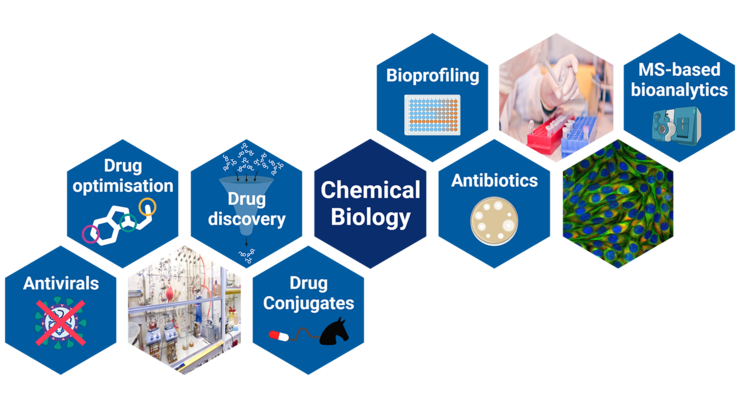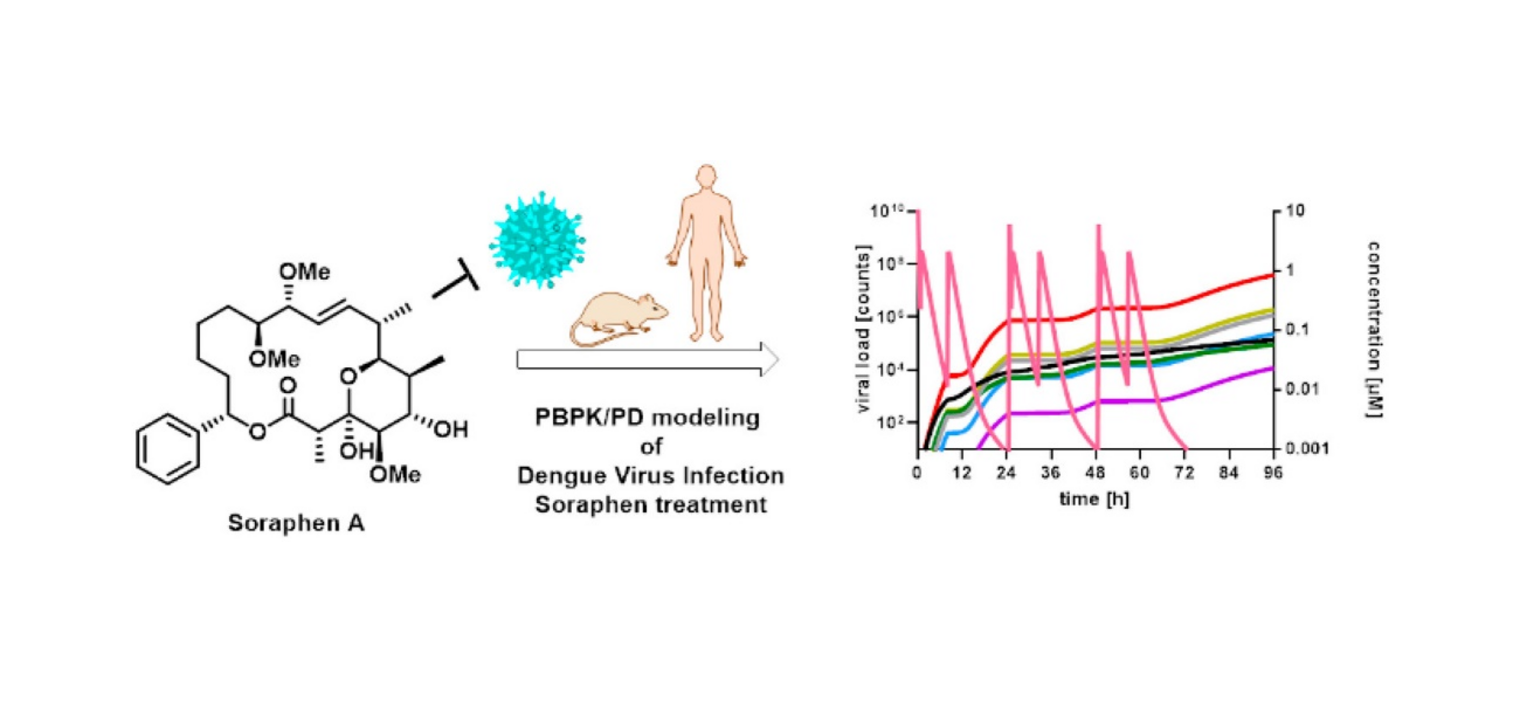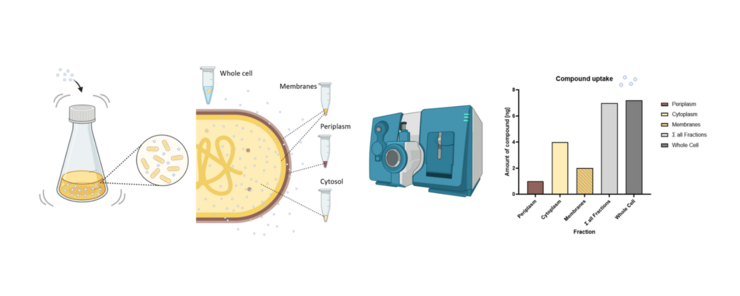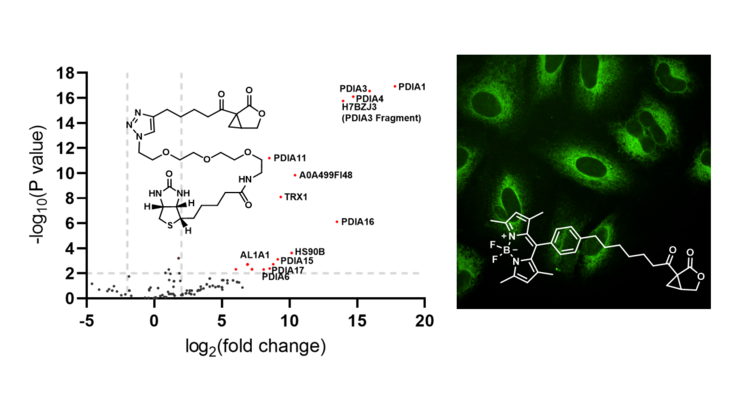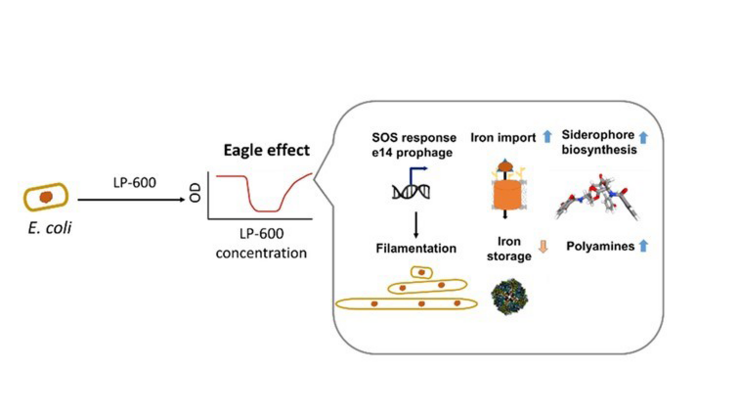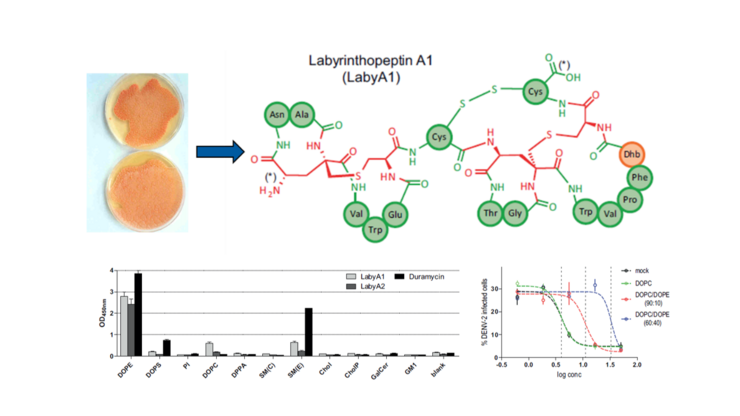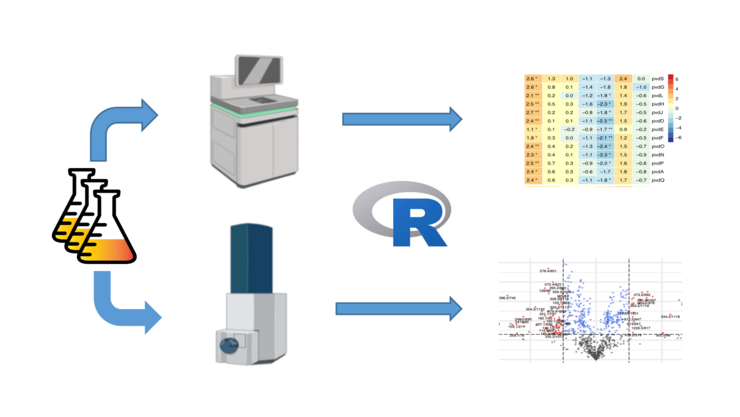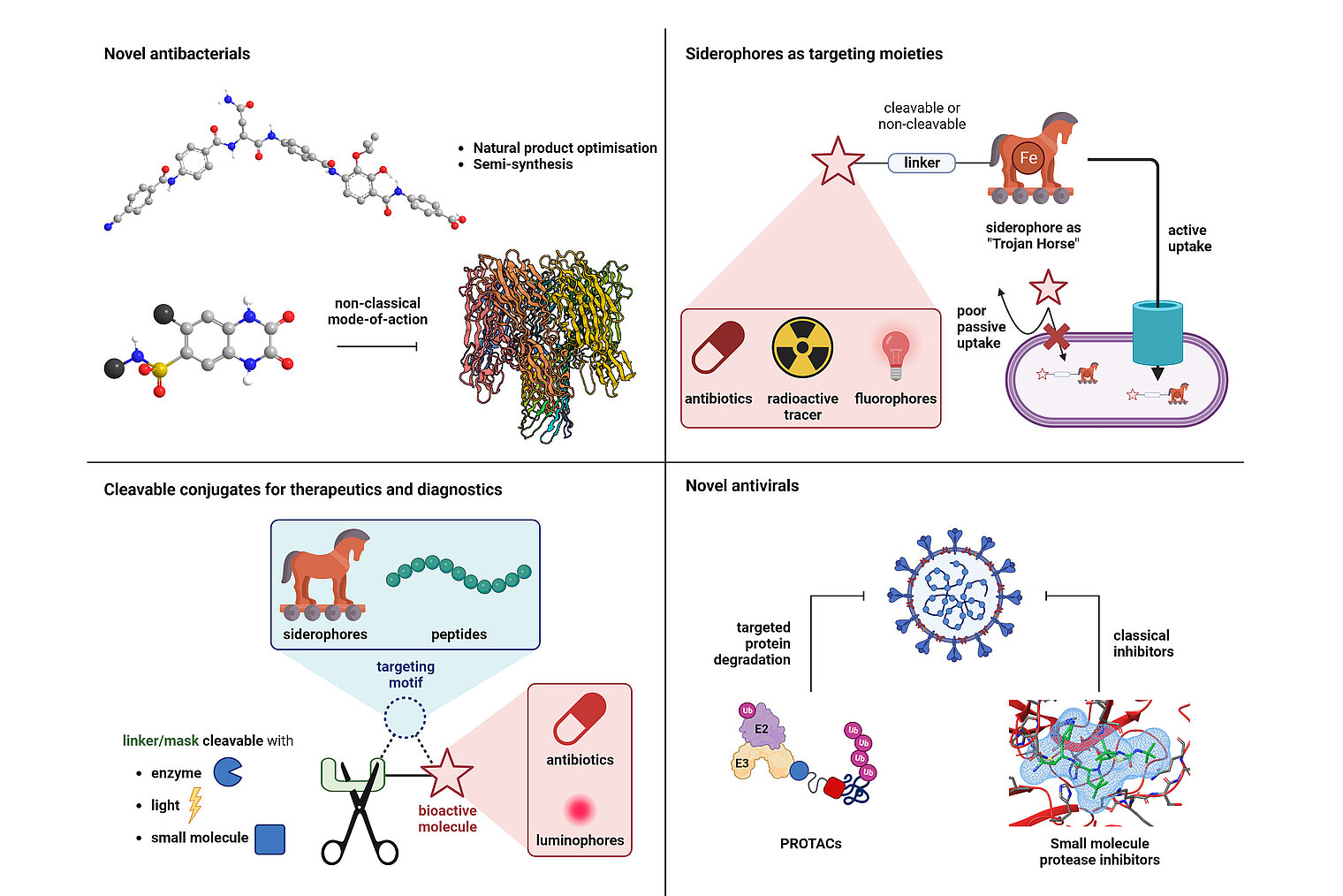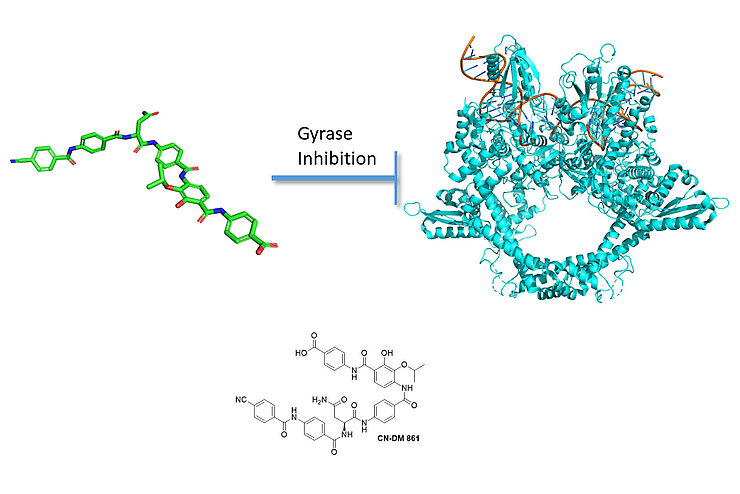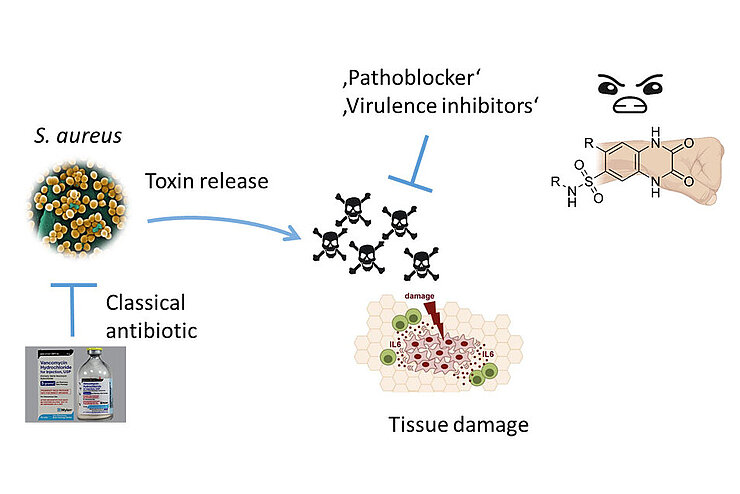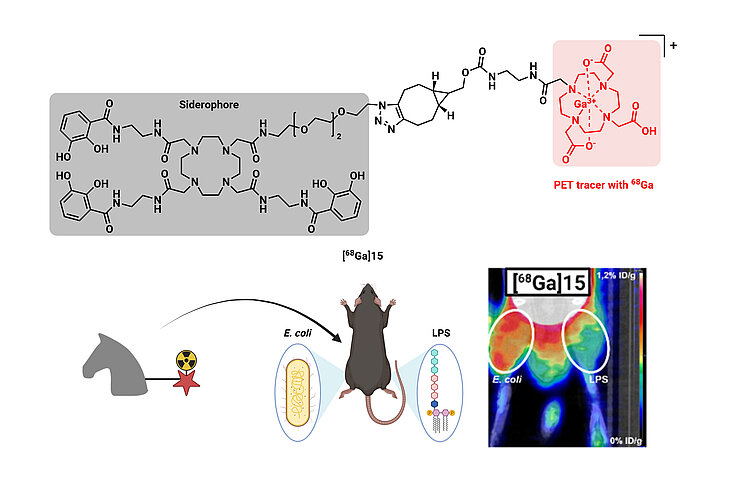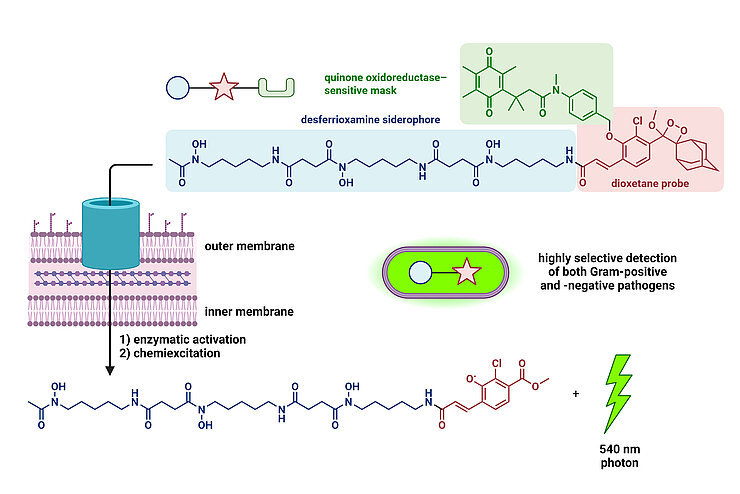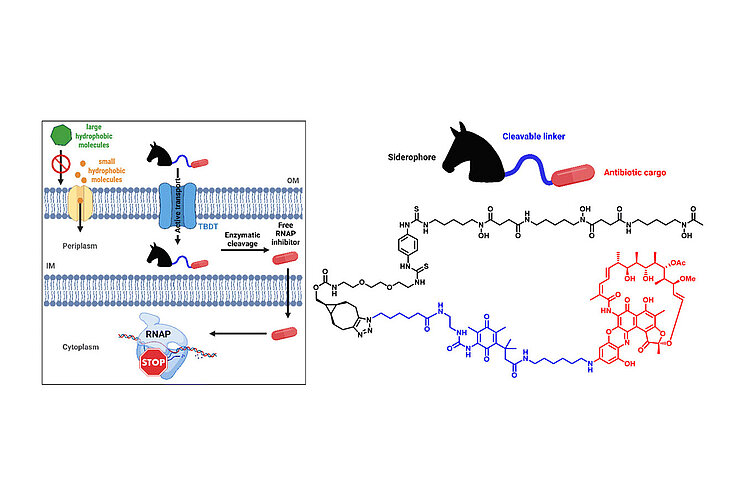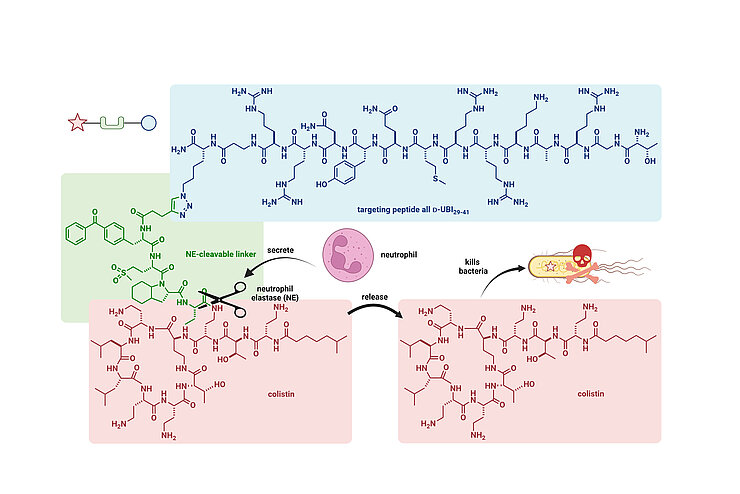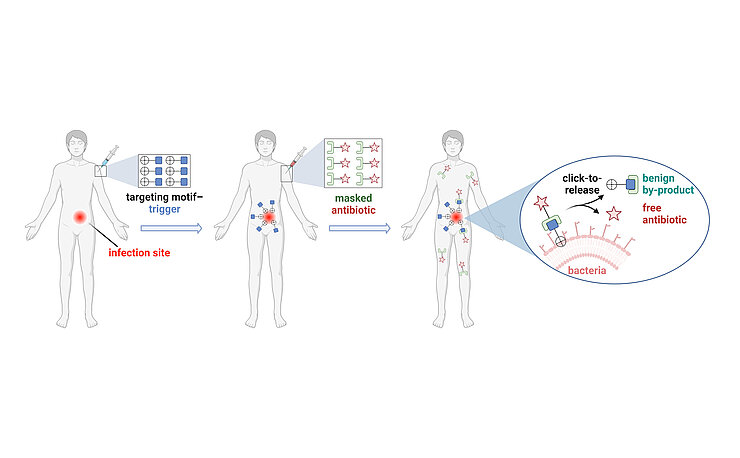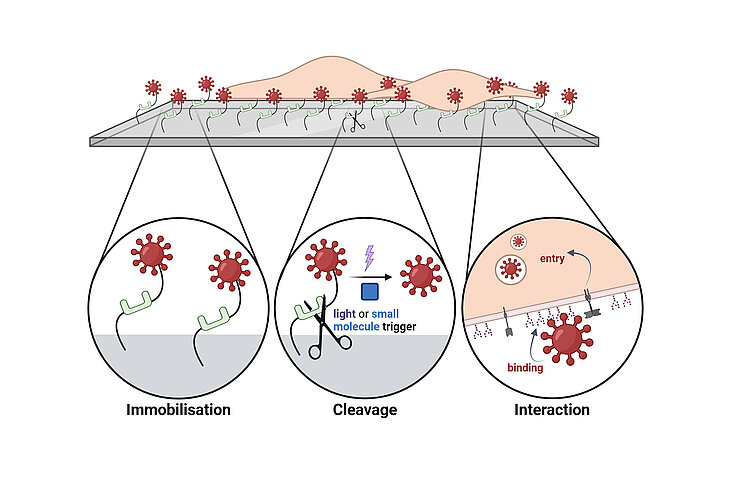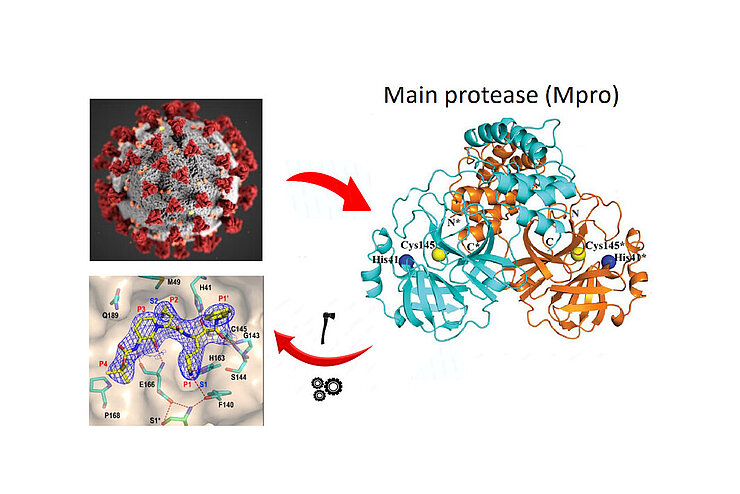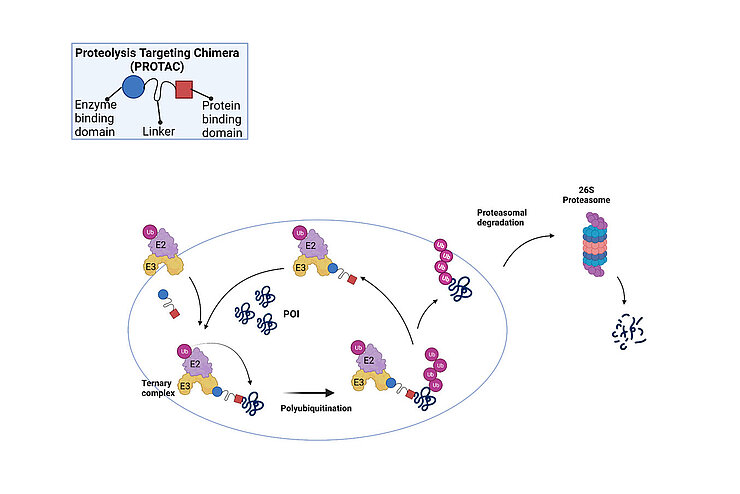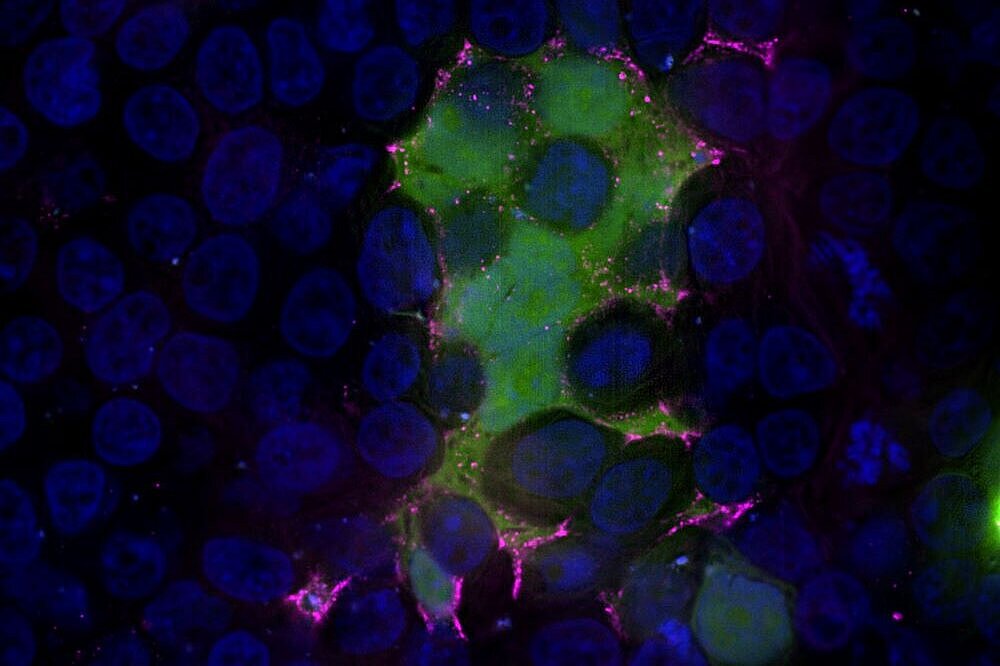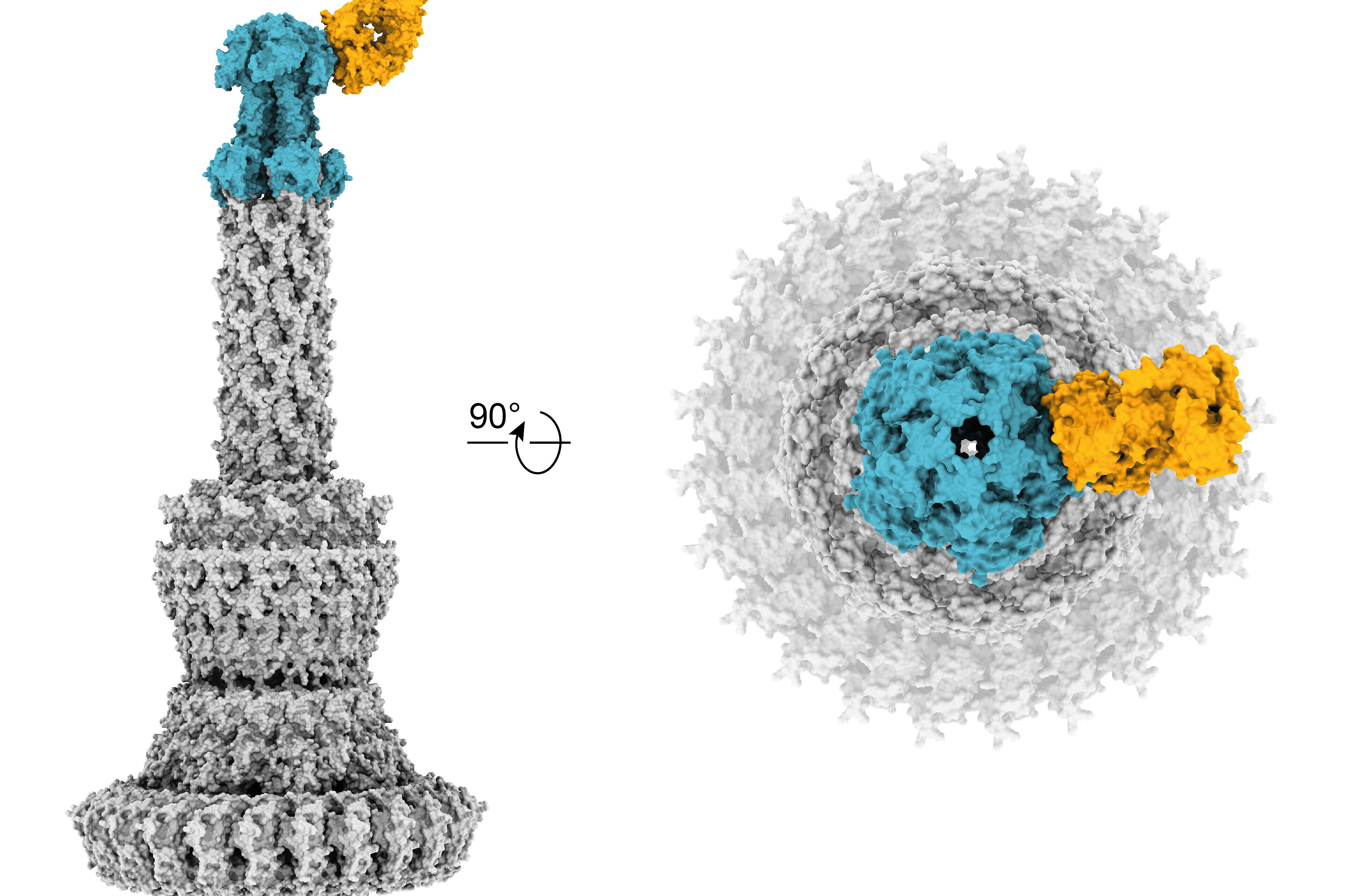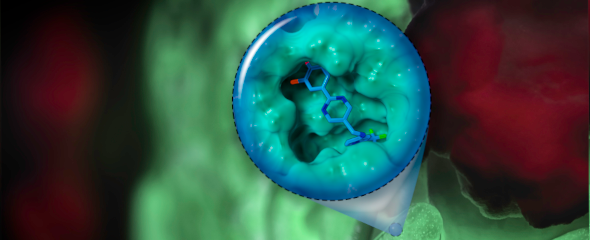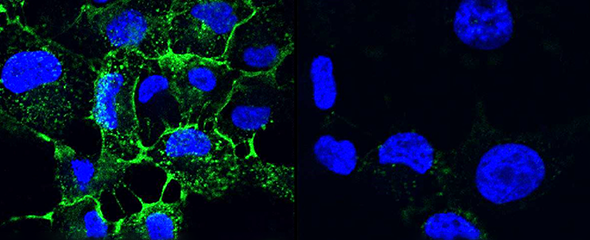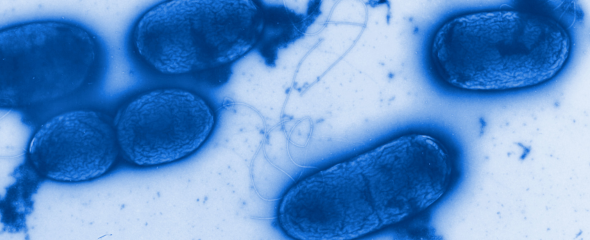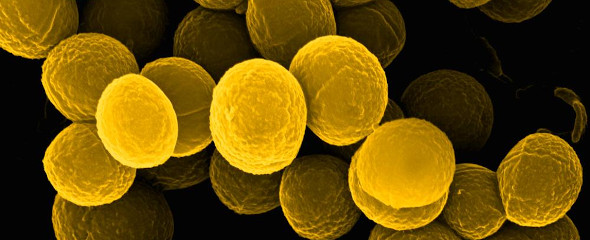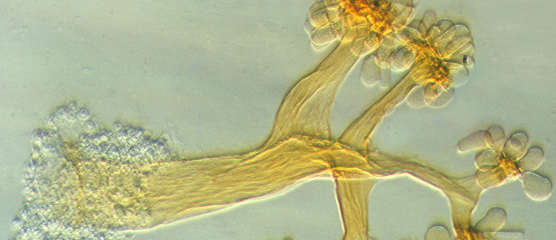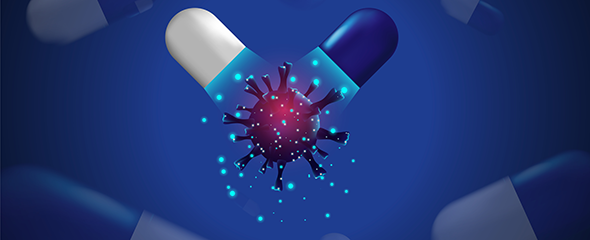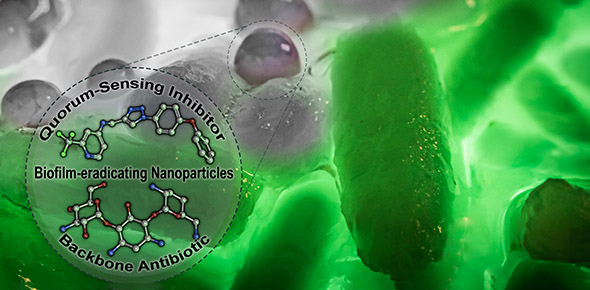Author count: 12
Li Q., Jansen H., Hansen G., Nurjadi D., Herrmann J., Stadler M., Brönstrup M., Müller R., He C., Graspeuntner S., ... , Rupp J., Shima K.
(2024)
Inhibitory effect of sorangicin A against mutant DNA-dependent RNA polymerase in the obligate intracellular bacterium Chlamydia trachomatis
Int.J.Antimicrob.Agents
Author count: 7
Jerye K., Lüken H., Steffen A., Schlawis C., Jänsch L., ... , Schulz S., Brönstrup M.
(2024)
Activity-Based Protein Profiling Identifies Protein Disulfide-Isomerases as Target Proteins of the Volatile Salinilactones
Adv.Sci.
Author count: 2
Rox K., Medina E.
(2024)
Aerosolized delivery of ESKAPE pathogens for murine pneumonia models
Scientific Reports, 14 (1)
Author count: 32
Sake S.M., Zhang X., Rajak M.K., Urbanek-Quaing M., Carpentier A., Gunesch A.P., Grethe C., Matthaei A., R++ckert J., Galloux M., Larcher T., Le Goffic R., Hontonnou F., Chatterjee A.K., Johnson K., Morwood K., Rox K., Elgaher W.A.M., Huang J., Wetzke M., Hansen G., Fischer N., El+®ou+½t J.F., Rameix-Welti M.A., Hirsch A.K.H., Herold E., Empting M., Lauber C., Schulz T.F., Krey T., ... , Haid S., Pietschmann T.
(2024)
Drug repurposing screen identifies lonafarnib as respiratory syncytial virus fusion protein inhibitor
Nature Communications, 15 (1)
Author count: 109
Zuffa S., Schmid R., Bauermeister A., Gomes P., Caraballo-Rodriguez A.M., El Abiead Y., Aron A.T., Gentry E.C., Zemlin J., Meehan M.J., Avalon N.E., Cichewicz R.H., Buzun E., Terrazas M.C., Hsu C.Y., Oles R., Ayala A.V., Zhao J., Chu H., Kuijpers M.C.M., Jackrel S.L., Tugizimana F., Nephali L.P., Dubery I.A., Madala N.E., Moreira E.A., Costa-Lotufo L.V., Lopes N.P., Rezende-Teixeira P., Jimenez P.C., Rimal B., Patterson A.D., Traxler M.F., Pessotti R.D.C., Alvarado-Villalobos D., Tamayo-Castillo G., Chaverri P., Escudero-Leyva E., Quiros-Guerrero L.M., Bory A.J., Joubert J., Rutz A., Wolfender J.L., Allard P.M., Sichert A., Pontrelli S., Pullman B.S., Bandeira N., Gerwick W.H., Gindro K., Massana-Codina J., Wagner B.C., Forchhammer K., Petras D., Aiosa N., Garg N., Liebeke M., Bourceau P., Kang K.B., Gadhavi H., Carvalho L.P.S., Silva dos Santos M., Perez-Lorente A.I., Molina-Santiago C., Romero D., Franke R., Brönstrup M., Vera-Ponce de Leon A., Pope P.B., La Rosa S.L., La Barbera G., Roager H.M., Laursen M.F., Hammerle F., Siewert B., Peintner U., Licona-Cassani C., Rodriguez-Orduna L., Rampler E., Hildebrand F., Koellensperger G., Schoeny H., Hohenwallner K., Panzenboeck L., Gregor R., O'Neill E.C., Roxborough E.T., Odoi J., Bale N.J., Ding S., Sinninghe Damste J.S., Guan X.L., Cui J.J., Ju K.S., Silva D.B., Silva F.M.R., da Silva G.F., Koolen H.H.F., Grundmann C., Clement J.A., Mohimani H., Broders K., McPhail K.L., Ober-Singleton S.E., Rath C.M., McDonald D., Knight R., ... , Wang M., Dorrestein P.C.
(2024)
microbeMASST: a taxonomically informed mass spectrometry search tool for microbial metabolomics data
Nature microbiology, 9 (2)
Author count: 9
Pfütze S., Charria-Giron E., Schulzke E., Toshe R., Khonsanit A., Franke R., Surup F., ... , Brönstrup M., Stadler M.
(2024)
Depicting the Chemical Diversity of Bioactive Meroterpenoids Produced by the Largest Organism on Earth
Angew.Chem.Int.Ed Engl.
Author count: 22
Haid S., Matthaei A., Winkler M., Sake S.M., Gunesch A.P., Milke V., Köhler N.M., Rückert J., Vieyres G., Kühl D., Nguyen T.-T., Göhl M., Lasswitz L., Zapatero-Belinchon F.J., Brogden G., Gerold G., Wiegmann B., Bilitewski U., Brown R.J.P., Brönstrup M., ... , Schulz T.F., Pietschmann T.
(2024)
Repurposing screen identifies novel candidates for broad-spectrum coronavirus antivirals and druggable host targets
Antimicrob.Agents Chemother.
Author count: 10
Berger T., Alenfelder J., Steinmüller S., Heimann D., Gohain N., Petras D., Wang M., Berger R., ... , Kostenis E., Reher R.
(2024)
A MassQL-Integrated Molecular Networking Approach for the Discovery and Substructure Annotation of Bioactive Cyclic Peptides
J.Nat.Prod.
Author count: 5
Eggert A., Schuppe K.T., Fuchs H.L.S., Brönstrup M., Kalesse M.
(2023)
Total Synthesis of Acanthodoral Using a Rearrangement Strategy
Organic Letters
Author count: 21
Flury P., Breidenbach J., Krüger N., Voget R., Schäkel L., Si Y., Krasniqi V., Calistri S., Olfert M., Sylvester K., Rocha C., Ditzinger R., Rasch A., Pöhlmann S., Kronenberger T., Poso A., Rox K., Laufer S.A., Müller C.E., ... , Gütschow M., Pillaiyar T.
(2023)
Cathepsin-Targeting SARS-CoV-2 Inhibitors: Design, Synthesis, and Biological Activity
ACS Pharmacology and Translational Science
Author count: 9
Mahdavi S.M., Bockfeld D., Büssing R., Karge B., Bannenberg T., Frank R., Brönstrup M., ... , Ott I., Tamm M.
(2024)
Synthesis of N-heterocyclic carbene gold(i) complexes from the marine betaine 1,3-dimethylimidazolium-4-carboxylate
Dalton Transactions
Author count: 18
Rox K., Jansen R., Lukezic T., Greweling-Pils M., Herrmann J., Miethke M., Hüttel S., Hennessen F., Abou Fayad A., Holzhausen C., Lundberg C.V., Teague J., Sudarman E., Bülter L., Hesterkamp T., Stadler M., ... , Brönstrup M., Müller R.
(2024)
Pharmacokinetic and pharmacodynamic evaluation of the atypical tetracyclines chelocardin and amidochelocardin in murine infection models
Microbiol.Spectr., 12 (1)
Author count: 21
Konstantinovic J., Kany A.M., Alhayek A., Abdelsamie A.S., Sikandar A., Voos K., Yao Y., Andreas A., Shafiei R., Loretz B., Schönauer E., Bals R., Brandstetter H., Hartmann R.W., Ducho C., Lehr C.M., Beisswenger C., Müller R., Rox K., ... , Haupenthal J., Hirsch A.K.
(2023)
Inhibitors of the Elastase LasB for the Treatment of Pseudomonas aeruginosa Lung Infections
ACS Cent.Sci., 9 (12)
Author count: 30
Couturier C., Ronzon Q., Lattanzi G., Lingard I., Coyne S., Cazals V., Dubarry N., Yvon S., Leroi-Geissler C., Gracia O.R., Teague J., Sordello S., Corbett D., Bauch C., Monlong C., Payne L., Taillier T., Fuchs H., Broenstrup M., Harrison P.H., Moynie L., Lakshminarayanan A., Gianga T.M., Hussain R., Naismith J.H., Mourez M., Bacque E., Björkling F., ... , Sabuco J.F., Franzyk H.
(2024)
Studies of antibacterial activity (in vitro and in vivo) and mode of action for des-acyl tridecaptins (DATs)
Eur.J.Med.Chem., 265
Author count: 8
Charria-Giron E., Marin-Felix Y., Beutling U., Franke R., Brönstrup M., Vasco-Palacios A.M., ... , Caicedo N.H., Surup F.
(2023)
Metabolomics insights into the polyketide-lactones produced by Diaporthe caliensis sp. nov., an endophyte of the medicinal plant Otoba gracilipes
Microbiol.Spectr.
Author count: 7
Schwitalla J.W., Le N.T.H., Um S., Schalk F., Brönstrup M., ... , Baunach M., Beemelmanns C.
(2023)
Heterologous expression of the cryptic mdk gene cluster and structural revision of maduralactomycin A
RSC Adv., 13 (48)
Author count: 28
Simonis A., Kreer C., Albus A., Rox K., Yuan B., Holzmann D., Wilms J.A., Zuber S., Kottege L., Winter S., Meyer M., Schmitt K., Gruell H., Theobald S.J., Hellmann A.M., Meyer C., Ercanoglu M.S., Cramer N., Munder A., Hallek M., F+ñtkenheuer G., Koch M., Seifert H., Rietschel E., Marlovits T.C., van Koningsbruggen-Rietschel S., ... , Klein F., Rybniker J.
(2023)
Discovery of highly neutralizing human antibodies targeting Pseudomonas aeruginosa
Cell, 186 (23)
Author count: 4
Schneider I., Fetz V., Prochnow H.P., Brönstrup M.
(2023)
Artificial Siderophores with a Trihydroxamate-DOTAM Scaffold Deliver Iron and Antibiotic Cargo into the Bacterial Pathogen Escherichia coli
Isr.J.Chem., 63 (7-8)
Author count: 9
Jian L., Zscherp R., Beutling U., Shen X., Xu S., Zhang X., Brönstrup M., ... , Klahn P., Sun Q.
(2023)
Discovery of Aminoratjadone Derivatives as Potent Noncovalent CRM1 Inhibitors
J.Med.Chem.
Author count: 8
Wu Y., Zoller B.G.E., Kamal M.A.M., Hotop S.K., Lehr C.M., Brönstrup M., ... , Dersch P., Empting M.
(2023)
Establishment of an In Bacterio assay for the Assessment of Carbon Storage Regulator A (CsrA) inhibitors
Chembiochem.
Author count: 14
Allartz P., Hotop S.K., Muntau B., Schlaphof A., Thome-Bolduan C., Gabriel M., Petersen N., Lintzel M., Behrens C., Eggert P., Pörtner K., Steiner J., ... , Brönstrup M., Tappe D.
(2023)
Detection of bornavirus-reactive antibodies and BoDV-1 RNA only in encephalitis patients from virus endemic areas: a comparative serological and molecular sensitivity, specificity, predictive value, and disease duration correlation study
Infection
Author count: 5
Friederich J., Xu C., Raunft P., Fuchs H.L.S., Brönstrup M.
(2023)
Tetrazine-induced activation of a trimethyl lock as a click-to-release system for protected doxorubicin
Chem.Commun., 59 (48)
Author count: 16
Graspeuntner S., Koethke K., Scholz C., Semmler L., Lupatsii M., Kirchhoff L., Herrmann J., Rox K., Wittstein K., Käding N., Hanker L.C., Stadler M., Bönstrup M., Müller R., ... , Shima K., Rupp J.
(2023)
Sorangicin A Is Active against Chlamydia in Cell Culture, Explanted Fallopian Tubes, and Topical In Vivo Treatment
Antibiotics.(Basel), 12 (5)
Author count: 7
Peukert C., Vetter A.C., Fuchs H.L.S., Harmrolfs K., Karge B., ... , Stadler M., Brönstrup M.
(2023)
Siderophore conjugation with cleavable linkers boosts the potency of RNA polymerase inhibitors against multidrug-resistant E. coli
Chem.Sci., 14
Author count: 2
Khalid K., Rox K.
(2023)
All Roads Lead to Rome: Enhancing the Probability of Target Attainment with Different Pharmacokinetic/Pharmacodynamic Modelling Approaches
Antibiotics.(Basel), 12 (4)
Author count: 8
Cedeno-Sanchez M., Charria-Giron E., Lambert C., Luangsa-ard J.J., Decock C., Franke R., ... , Brönstrup M., Stadler M.
(2023)
Segregation of the genus Parahypoxylon (Hypoxylaceae, Xylariales) from Hypoxylon by a polyphasic taxonomic approach
MycoKeys, 95
Author count: 4
Abouzeid S., Beutling U., Elekhnawy E., Selmar D.
(2023)
Antibacterial and Antibiofilm Effects of Allelopathic Compounds Identified in Medicago sativa L. Seedling Exudate against Escherichia coli
Molecules., 28 (6)
Author count: 6
Zapol'skii V.A., Kaul S., Karge B., Brönstrup M., Gjikaj M., Kaufmann D.E.
(2023)
A New Way to 2,3,4-Trisubstituted Benzo[h]quinolines: Synthesis, Consecutive Reactions and Cellular Activities â
Molecules., 28 (6)
Author count: 14
Maingot M., Bourotte M., Vetter A.C., Schellhorn B., Antraygues K., Scherer H., Gitzinger M., Kemmer C., Dale G.E., Defert O., Lociuro S., Brönstrup M., ... , Willand N., Trebosc V.
(2023)
Structure-activity relationships of actively FhuE transported rifabutin derivatives with potent activity against Acinetobacter baumannii
Eur.J.Med.Chem., 252
Author count: 5
Lai Y.H., Franke R., Pinkert L., Overwin H., Brönstrup M.
(2023)
Molecular Signatures of the Eagle Effect Induced by the Artificial Siderophore Conjugate LP-600 in E. coli
ACS Infect.Dis., 9 (3)
Author count: 5
Peukert C., Rox K., Karge B., Hotop S.K., Brönstrup M.
(2023)
Synthesis and Characterization of DOTAM-Based Sideromycins for Bacterial Imaging and Antimicrobial Therapy
ACS Infect.Dis., 9 (2)
Author count: 18
Hamed M.M., Abdelsamie A.S., Rox K., Schütz C., Kany A.M., Röhrig T., Schmelz S., Blankenfeldt W., Arce-Rodriguez A., Borrero-de Acuna J.M., Jahn D., Rademacher J., Ringshausen F.C., Cramer N., Tümmler B., Hirsch A.K.H., ... , Hartmann R.W., Empting M.
(2023)
Towards Translation of PqsR Inverse Agonists: From In Vitro Efficacy Optimization to In Vivo Proof-of-Principle
Adv.Sci.
Author count: 15
Rox K., Becker T., Schiefer A., Grosse M., Ehrens A., Jansen R., Aden T., Kehraus S., König G.M., Krome A.K., Hübner M.P., Wagner K.G., Stadler M., ... , Pfarr K., Hoerauf A.
(2022)
Pharmacokinetics and Pharmacodynamics (PK/PD) of Corallopyronin A against Methicillin-Resistant Staphylococcus aureus
Pharmaceutics, 15 (1)
Author count: 17
Wimmer S., Hoff K., Martin B., Grewer M., Denni L., Lascorz Massanet R., Raimondi M.V., Bülbül E.F., Melesina J., Hotop S.K., Haupenthal J., Rohde H., Heisig P., Hirsch A.K.H., Brönstrup M., ... , Sippl W., Holl R.
(2022)
Synthesis, biological evaluation, and molecular docking studies of aldotetronic acid-based LpxC inhibitors
Bioorg.Chem., 131
Author count: 17
Borgert S.R., Henke S., Witzgall F., Schmelz S., Zur Lage S., Hotop S.K., Stephen S., Lübken D., Krüger J., Gomez N.O., Van Ham M., Jänsch L., Kalesse M., Pich A., Brönstrup M., ... , Häußler S., Blankenfeldt W.
(2022)
Moonlighting chaperone activity of the enzyme PqsE contributes to RhlR-controlled virulence of Pseudomonas aeruginosa
Nat.Commun., 13 (1)
Author count: 8
Peukert C., Gasser V., Orth T., Fritsch S., Normant V., Cunrath O., ... , Schalk I.J., Brönstrup M.
(2022)
Trojan Horse Siderophore Conjugates Induce Pseudomonas aeruginosa Suicide and Qualify the TonB Protein as a Novel Antibiotic Target
J.Med.Chem., 66 (1)
Author count: 12
Zahorska E., Rosato F., Stober K., Kuhaudomlarp S., Meiers J., Hauck D., Reith D., Gillon E., Rox K., Imberty A., ... , Römer W., Titz A.
(2022)
Neutralizing the Impact of the Virulence Factor LecA from Pseudomonas aeruginosa on Human Cells with New Glycomimetic Inhibitors
Angew.Chem.Int.Ed Engl.
Author count: 11
Hassan K., Matio Kemkuignou B., Kirchenwitz M., Wittstein K., Rascher-Albaghdadi M., Chepkirui C., Matasyoh J.C., Decock C., Köster R.W., ... , Stradal T.E.B., Stadler M.
(2022)
Neurotrophic and Immunomodulatory Lanostane Triterpenoids from Wood-Inhabiting Basidiomycota
Int.J.Mol.Sci., 23 (21)
Author count: 11
Kruck D., Bode H., Krusche J., Beck C., Ohlsen K., Sander J., Römling U., Burrichter A., Varo J.G., ... , Charoenpattarapreeda J., Brönstrup M.
(2022)
Journal Club : [u.a.] Gesteuerter Abbau von Proteinen in Bakterien durch BacPROTAC-Wirkstoffe [etc.]
Biospektrum, 28 (7)
Author count: 6
Fiorini F., Bajerski F., Jeske O., Lepleux C., Overmann J., Brönstrup M.
(2022)
A Metabolomics-Based Toolbox to Assess and Compare the Metabolic Potential of Unexplored, Difficult-to-Grow Bacteria
Mar Drugs, 20 (11)
Author count: 1
Rox K.
(2022)
Influence of tramadol on bacterial burden in the standard neutropenic thigh infection model
Sci.Rep., 12 (1)
Author count: 3
Meiers J., Rox K., Titz A.
(2022)
Lectin-Targeted Prodrugs Activated by Pseudomonas aeruginosa for Self-Destructive Antibiotic Release
J.Med.Chem., 65 (20)
Author count: 7
Mala P., Siebs E., Meiers J., Rox K., Varrot A., ... , Imberty A., Titz A.
(2022)
Discovery of N-ß-l-Fucosyl Amides as High-Affinity Ligands for the Pseudomonas aeruginosa Lectin LecB
J.Med.Chem.
Author count: 18
Cooper M.S., Zhang L., Ibrahim M., Zhang K., Sun X., Röske J., Göhl M., Brönstrup M., Cowell J.K., Sauerhering L., Becker S., Vangeel L., Jochmans D., Neyts J., Rox K., Marsh G.P., ... , Maple H.J., Hilgenfeld R.
(2022)
Diastereomeric Resolution Yields Highly Potent Inhibitor of SARS-CoV-2 Main Protease
J.Med.Chem., 65 (19)
Author count: 11
Suo H., Hochnadel I., Petriv N., Franke R., Schmidt J., Limanska N., Tugai A., Jedicke N., Brönstrup M., ... , Manns M.P., Yevsa T.
(2022)
Elucidating the mechanism behind and investigating the efficacy of Traditional Chinese Medicine and Traditional Tibetan Medicine in combination with standard therapeutics in hepatocellular carcinoma and cholangiocarcinoma in vitro
Front Pharmacol., 13
Author count: 6
Testolin G., Richter J., Ritter A., Prochnow H., Köhnke J., Brönstrup M.
(2022)
Optical Modulation of Antibiotic Resistance by Photoswitchable Cystobactamids
Chem.Eur.J.
Author count: 7
Göhl M., Zhang L., El Kilani H., Sun X., Zhang K., ... , Brönstrup M., Hilgenfeld R.
(2022)
From Repurposing to Redesign: Optimization of Boceprevir to Highly Potent Inhibitors of the SARS-CoV-2 Main Protease G
Molecules, 27 (13)
Author count: 12
Suerbaum S., Coombs N., Patel L., Pscheniza D., Rox K., Falk C., Gruber A.D., Kershaw O., Chhatwal P., Brönstrup M., ... , Bilitewski U., Josenhans C.
(2022)
Correction for Suerbaum et al., "Identification of Antimotilins, Novel Inhibitors of Helicobacter pylori Flagellar Motility That Inhibit Stomach Colonization in a Mouse Model"
MBio.
Author count: 16
Arshad H., Siokis A., Franke R., Habib A., Alfonso J.C.L., Poliakova Y., Lücke E., Michaelis K., Brönstrup M., Meyer-Hermann M., Bilitewski U., Vila J., Abel L., Illig T., ... , Schreiber J., Pessler F.
(2022)
Reprogramming of Amino Acid Metabolism Differs between Community-Acquired Pneumonia and Infection-Associated Exacerbation of Chronic Obstructive Pulmonary Disease
Cells, 11 (15)
Author count: 14
Brauer M., Hotop S.K., Wurster M., Herrmann J., Miethke M., Schlüter R., Dittmann S., Zühlke D., Brönstrup M., Lalk M., Müller R., Sievers S., ... , Bernhardt J., Riedel K.
(2022)
Clostridioides difficile Modifies its Aromatic Compound Metabolism in Response to Amidochelocardin-Induced Membrane Stress
mSphere
Author count: 10
Hiebeler M., Franke R., Ingenerf M., Krause S., Mohassel P., Pak K., Mammen A., Schoser B., ... , Bönnemann C.G., Walter M.C.
(2022)
Slowly Progressive Limb-Girdle Weakness and HyperCKemia - Limb Girdle Muscular Dystrophy or Anti-3-Hydroxy-3-Methylglutaryl-CoA-Reductase-Myopathy?
J.Neuromuscul.Dis.
Author count: 15
Ballmann R., Hotop S.K., Bertoglio F., Steinke S., Heine P.A., Chaudhry M.Z., Jahn D., Pucker B., Baldanti F., Piralla A., Schubert M., Cícín-Saín L., Brönstrup M., ... , Hust M., Dübel S.
(2022)
ORFeome Phage Display Reveals a Major Immunogenic Epitope on the S2 Subdomain of SARS-CoV-2 Spike Protein
Viruses., 14 (6)
Author count: 9
Fritsch S., Gasser V., Peukert C., Pinkert L., Kuhn L., Perraud Q., Normant V., ... , Brönstrup M., Schalk I.J.
(2022)
Uptake Mechanisms and Regulatory Resfponses to MECAM- and DOTAM-Based Artificial Siderophores and Their Antibiotic Conjugates in Pseudomonas aeruginosa
ACS Infect.Dis., 8 (6)
Author count: 8
Peukert C., Popat Gholap S., Green O., Pinkert L., van den Heuvel J., Van Ham M., ... , Shabat D., Brönstrup M.
(2022)
Enzyme-Activated, Chemiluminescent Siderophore-Dioxetane Probes Enable the Selective and Highly Sensitive Detection of Bacterial Pathogens
Angew.Chem.Int.Ed Engl.
Author count: 12
Suerbaum S., Coombs N., Patel L., Pscheniza D., Rox K., Falk C., Gruber A.D., Kershaw O., Chhatwal P., Brönstrup M., ... , Bilitewski U., Josenhans C.
(2022)
Identification of Antimotilins, Novel Inhibitors of Helicobacter pylori Flagellar Motility That Inhibit Stomach Colonization in a Mouse Model
MBio., 13 (2)
Author count: 16
Hotop S.K., Reimering S., Shekhar A., Asgari E., Beutling U., Dahlke C., Fathi A., Khan F., Lütgehetmann M., Ballmann R., Gerstner A., Tegge W., Cicin-Sain L., Bilitewski U., ... , McHardy A.C., Brönstrup M.
(2022)
Peptide microarrays coupled to machine learning reveal individual epitopes from human antibody responses with neutralizing capabilities against SARS-CoV-2
Emerg.Microbes Infect, 11 (1)
Author count: 30
Hezaveh K., Shinde R.S., Klötgen A., Halaby M.J., Lamorte S., Ciudad M.T., Quevedo R., Neufeld L., Liu Z.Q., Jin R., Grünewald B.T., Foerster E.G., Chaharlangi D., Guo M., Makhijani P., Zhang X., Pugh T.J., Pinto D.M., Co I.L., McGuigan A.P., Jang G.H., Khokha R., Ohashi P.S., O'Kane G.M., Gallinger S., Navarre W.W., Maughan H., Philpott D.J., ... , Brooks D.G., McGaha T.L.
(2022)
Tryptophan-derived microbial metabolites activate the aryl hydrocarbon receptor in tumor-associated macrophages to suppress anti-tumor immunity
Immunity, 55 (2)
Author count: 4
Vetter A.C., Müller-Bunz H., Muldoon J., Nikitin K.
(2021)
Quaternary Phosphonium Carboxylates: Structure, Dynamics and Intriguing Olefination Mechanism
Synthesis
Author count: 19
Arisetti N., Fuchs H.L.S., Coetzer J., Orozco M., Ruppelt D., Bauer A., Heimann D., Kuhnert E., Bhamidimarri S.P., Bafna J.A., Hinkelmann B., Eckel K., Sieber S.A., Müller P.P., Herrmann J., Müller R., Winterhalter M., ... , Steinem C., Brönstrup M.
(2021)
Total synthesis and mechanism of action of the antibiotic armeniaspirol A
Chem.Sci., 12 (48)
Author count: 6
Ahsendorf H.P., Diesterbeck U.S., Hotop S.K., Winkler M., Brönstrup M., Czerny C.P.
(2022)
Characterisation of an Anti-Vaccinia Virus F13 Single Chain Fragment Variable from a Human Anti-Vaccinia Virus-Specific Recombinant Immunoglobulin Library
Viruses, 14 (2)
Author count: 10
Hotop S.K., Abd El Wahed A., Beutling U., Czerny F., Sievers C., Diederichsen U., Frank R., Stahl-Hennig C., ... , Brönstrup M., Fritz H.J.
(2019)
Serological Analysis of Herpes B Virus at Individual Epitope Resolution: From Two-Dimensional Peptide Arrays to Multiplex Bead Flow Assays
Anal.Chem., 91 (17)
Author count: 8
Roche B., Garcia-Rivera M.A., Normant V., Kuhn L., Hammann P., Brönstrup M., ... , Mislin G.L.A., Schalk I.J.
(2021)
A role for PchHI as the ABC transporter in iron acquisition by the siderophore pyochelin in Pseudomonas aeruginosa
Environmental Microbiology
Author count: 6
Jimidar C.C., Grunenberg J., Karge B., Fuchs H.L.S., Brönstrup M., Klahn P.
(2021)
Masked Amino Trimethyl Lock (H2N-TML) Systems: New Molecular Entities for the Development of Turn-On Fluorophores and Their Application in Hydrogen Sulfide (H2S) Imaging in Human Cells
Chemistry - A European Journal
Author count: 23
Becker K., Cao S., Nilsson A., Erlandsson M., Hotop S.K., Kuka J., Hansen J., Haldimann K., Grinberga S., Berruga-Fernández T., Huseby D.L., Shariatgorji R., Lindmark E., Platzack B., Böttger E.C., Crich D., Friberg L.E., Vingsbo Lundberg C., Hughes D., Brönstrup M., Andrén P.E., ... , Liepinsh E., Hobbie S.N.
(2021)
Antibacterial activity of apramycin at acidic pH warrants wide therapeutic window in the treatment of complicated urinary tract infections and acute pyelonephritis
EBioMedicine, 73 (November 2021)
Author count: 8
Pinkert L., Lai Y.H., Peukert C., Hotop S.K., Karge B., Schulze L.M., ... , Grunenberg J., Brönstrup M.
(2021)
Antibiotic Conjugates with an Artificial MECAM-Based Siderophore Are Potent Agents against Gram-Positive and Gram-Negative Bacterial Pathogens
J.Med.Chem.
Author count: 12
Rox K., Heyner M., Krull J., Harmrolfs K., Rinne V., Hokkanen J., Perez Vilaro G., Díez J., Müller R., Kröger A., ... , Sugiyama Y., Brönstrup M.
(2021)
Physiologically Based Pharmacokinetic/Pharmacodynamic Model for the Treatment of Dengue Infections Applied to the Broad Spectrum Antiviral Soraphen A
ACS Pharm.Transl.Sci., 4 (5)
Author count: 14
Freise C., Lee H., Chronowski C., Chan D., Cziomer J., Rühl M., Dagdelen T., Lösekann M., Erben U., Catic A., Tegge W., Schuppan D., ... , Somasundaram R., Sahin E.
(2021)
Alpha-single chains of collagen type VI inhibit the fibrogenic effects of triple helical collagen VI in hepatic stellate cells
PLoS.ONE., 16 (9)
Author count: 12
Rath S., Rox K., Kleine Bardenhorst S., Schminke U., Dörr M., Mayerle J., Frost F., Lerch M.M., Karch A., Brönstrup M., ... , Pieper D.H., Vital M.
(2021)
Higher Trimethylamine-N-Oxide Plasma Levels with Increasing Age Are Mediated by Diet and Trimethylamine-Forming Bacteria
mSystems.
Author count: 54
Miethke M., Pieroni M., Weber T., Brönstrup M., Hammann P., Halby L., Arimondo P.B., Glaser P., Aigle B., Bode H.B., Moreira R., Li Y., Luzhetskyy A., Medema M.H., Pernodet J.L., Stadler M., Tormo J.R., Genilloud O., Truman A.W., Weissman K.J., Takano E., Sabatini S., Stegmann E., Brötz-Oesterhelt H., Wohlleben W., Seemann M., Empting M., Hirsch A.K.H., Loretz B., Lehr C.M., Titz A., Herrmann J., Jaeger T., Alt S., Hesterkamp T., Winterhalter M., Schiefer A., Pfarr K., Hoerauf A., Graz H., Graz M., Lindvall M., Ramurthy S., Karlen A., van Dongen M., Petkovic H., Keller A., Peyrane F., Donadio S., Fraisse L., Piddock L.J.V., Gilbert I.H., ... , Moser H.E., Müller R.
(2021)
Towards the sustainable discovery and development of new antibiotics
Nat.Rev.Chem.
Author count: 9
Peukert C., Langer L.N.B., Wegener S.M., Tutov A., Bankstahl J.P., Karge B., Bengel F.M., ... , Ross T.L., Brönstrup M.
(2021)
Optimization of Artificial Siderophores as (68)Ga-Complexed PET Tracers for In Vivo Imaging of Bacterial Infections
J.Med.Chem., 64 (16)
Author count: 6
Büssing R., Karge B., Lippmann P., Jones P.G., Brönstrup M., Ott Ingo
(2021)
Gold(I) and Gold(III) N-Heterocyclic Carbene Complexes as Antibacterial Agents and Inhibitors of Bacterial Thioredoxin Reductase
ChemMedChem.
Author count: 5
Rox K., Rath S., Pieper D.H., Vital M., Brönstrup M.
(2021)
A simplified LC-MS/MS method for the quantification of the cardiovascular disease biomarker trimethylamine-N-oxide and its precursors
J.Pharmaceut.Analy.
Author count: 4
Franke R., Overwin H., Häussler S., Brönstrup M.
(2021)
Targeting Bacterial Gyrase with Cystobactamid, Fluoroquinolone, and Aminocoumarin Antibiotics Induces Distinct Molecular Signatures in Pseudomonas aeruginosa
mSystems.
Author count: 11
Tegge W., Guerra G., Höltke A., Schiller L., Beutling U., Harmrolfs K., Gröbe L., Wullenkord H., Xu C., ... , Weich H., Brönstrup M.
(2021)
Selective bacterial targeting and infection-triggered release of antibiotic colistin conjugates
Angew.Chem.Int.Ed Engl., 60 (33)
Author count: 10
Saretz S., Basset G., Useini L., Laube M., Pietzsch J., Draca D., Maksimoviç-Ivaniç D., Trambauer J., ... , Steiner H., Hey-Hawkins E.
(2021)
Modulation of g
Molecules, 26 (10)
Author count: 13
Hendry S., Steinke S., Wittstein K., Stadler M., Harmrolfs K., Adewunmi Y., Sahukhal G., Elasri M., Thomashow L., Weller D., Mavrodi O., ... , Blankenfeldt W., Mavrodi D.
(2021)
Functional Analysis of Phenazine Biosynthesis Genes in Burkholderia spp
Appl.Environ.Microbiol., 87 (11)
Author count: 26
Schütz C., Ho D.K., Hamed M.M., Abdelsamie A.S., Röhrig T., Herr C., Kany A.M., Rox K., Schmelz S., Siebenbürger L., Wirth M., Börger C., Yahiaoui S., Bals R., Scrima A., Blankenfeldt W., Horstmann J.C., Christmann R., Murgia X., Koch M., Berwanger A., Loretz B., Hirsch A.K.H., Hartmann R.W., ... , Lehr C.M., Empting M.
(2021)
A New PqsR Inverse Agonist Potentiates Tobramycin Efficacy to Eradicate Pseudomonas aeruginosa Biofilms
Adv.Sci.
Author count: 9
de Oliveira L.M.F., Steindorff M., Darisipudi M.N., Mrochen D.M., Trübe P., Bröker B.M., Brönstrup M., ... , Tegge W., Holtfreter S.
(2021)
Discovery of staphylococcus aureus adhesion inhibitors by automated imaging and their characterization in a mouse model of persistent nasal colonization
Microorg., 9 (3)
Author count: 9
Villanova V., Galasso C., Fiorini F., Lima S., Brönstrup M., Sansone C., Brunet C., ... , Brucato A., Scargiali F.
(2021)
Biological and chemical characterization of new isolated halophilic microorganisms from saltern ponds of Trapani, Sicily
Algal Res., 54 (April 2021)
Author count: 8
Dreger A., Hoff K., Agoglitta O., Hotop S.K., Brönstrup M., Heisig P., ... , Kirchmair J., Holl R.
(2021)
Antibacterial activity of xylose-derived LpxC inhibitors - Synthesis, biological evaluation and molecular docking studies
Bioorg.Chem., 107 (Febr. 2021)
Author count: 5
Hübner I., Dienemann J.N., Friederich J., Schneider S., Sieber S.A.
(2020)
Tailored Cofactor Traps for the in Situ Detection of Hemithioacetal-Forming Pyridoxal Kinases
ACS Chem.Biol., 15 (12)
Author count: 10
Lettl C., Schindele F., Testolin G., Bär A., Rehm T., Brönstrup M., Schobert R., Bilitewski U., ... , Haas R., Fischer W.
(2020)
Inhibition of Type IV Secretion Activity and Growth of Helicobacter pylori by Cisplatin and Other Platinum Complexes
Front Cell Infect.Microbiol., 10 (December 2020)
Author count: 18
Richter R., Kamal M.A.M., Garcia-Rivera M.A., Kaspar J., Junk M., Elgaher W.A.M., Srikakulam S.K., Gress A., Beckmann A., Grißmer A., Meier C., Vielhaber M., Kalinina O., Hirsch A.K.H., Hartmann R.W., Brönstrup M., ... , Schneider-Daum N., Lehr C.M.
(2020)
A hydrogel-based in vitro assay for the fast prediction of antibiotic accumulation in Gram-negative bacteria
Mater.Today Bio, 8
Author count: 20
Testolin G., Cirnski K., Rox K., Prochnow H., Fetz V., Grandclaudon C., Mollner T., Baiyoumy A., Ritter A., Leitner C., Krull J., van den Heuvel J., Vassort A., Sordello S., Hamed M.M., Elgaher W.A.M., Herrmann J., Hartmann R.W., ... , Müller R., Brönstrup M.
(2020)
Synthetic studies of cystobactamids as antibiotics and bacterial imaging carriers lead to compounds with high: In vivo efficacy
Chem.Sci., 11 (5)
Author count: 11
Rahim M.I., Winkel A., Lienenklaus S., Stumpp N.S., Szafranski S.P., Kommerein N., Willbold E., Reifenrath J., Müller P.P., ... , Eisenburger M., Stiesch M.
(2020)
Non-Invasive Luciferase Imaging of Type I Interferon Induction in a Transgenic Mouse Model of Biomaterial Associated Bacterial Infections: Microbial Specificity and Inter-Bacterial Species Interactions
Microorganisms., 8 (10)
Author count: 8
Wosniok P.R., Knopf C., Dreisigacker S., Orozco-Rodriguez J.M., Hinkelmann B., Müller P.P., ... , Brönstrup M., Menche D.
(2020)
SAR Studies of the Leupyrrins: Design and Total Synthesis of Highly Potent Simplified Leupylogs
Chem.Eur.J., 26 (66)
Author count: 3
Depke T., Häußler S., Brönstrup M.
(2020)
The peptide chain release factor methyltransferase prmc influences the pseudomonas aeruginosa pa14 endo-and exometabolome
Metabolites, 10 (10)
Author count: 9
Felgner S., Preusse M., Beutling U., Stahnke S., Pawar V., Rohde M., Brönstrup M., ... , Stradal T., Häußler S.
(2020)
Host-induced spermidine production in motile Pseudomonas aeruginosa triggers phagocytic uptake
Elife., 9 (September)
Author count: 14
Tegtmeyer N., Neddermann M., Lind J., Pachathundikandi S.K., Sharafutdinov I., Gutiérrez-Escobar A.J., Brönstrup M., Tegge W., Hong M., Rohde M., Delahay R.M., Vieth M., ... , Sticht H., Backert S.
(2020)
Toll-like Receptor 5 Activation by the CagY Repeat Domains of Helicobacter pylori
Cell Rep., 32 (11)
Author count: 5
Depke T., Thöming J.G., Kordes A., Häussler S., Brönstrup M.
(2020)
Untargeted LC-MS metabolomics differentiates between virulent and avirulent clinical strains of Pseudomonas aeruginosa
Biomolecules, 10 (7)
Author count: 4
Fiorini F., Borgonuovo C., Ferrante M.I., Brönstrup M.
(2020)
A Metabolomics Exploration of the Sexual Phase in the Marine Diatom Pseudo-nitzschia multistriata
Mar Drugs, 18 (6)
Author count: 9
Gunesch A.P., Zapatero-Belinchon F.J., Pinkert L., Steinmann E., Manns M.P., Schneider G., Pietschmann T., ... , Brönstrup M., von Hahn T.
(2020)
Filovirus antiviral activity of cationic amphiphilic drugs is associated with lipophilicity and ability to induce phospholipidosis
Antimicrob.Agents Chemother., 64 (8)
Author count: 2
Brönstrup M., Sasse F.
(2020)
Natural products targeting the elongation phase of eukaryotic protein biosynthesis
Nat.Prod.Rep., 37 (6)
Author count: 13
Mamareli P., Kruse F., Lu C.W., Guderian M., Floess S., Rox K., Allan D.S.J., Carlyle J.R., Brönstrup M., Müller R., Berod L., ... , Sparwasser T., Lochner M.
(2020)
Targeting cellular fatty acid synthesis limits T helper and innate lymphoid cell function during intestinal inflammation and infection
Mucosal Immunol., 14 (1)
Author count: 10
Samarakoon M.C., Thongbai B., Hyde K.D., Brönstrup M., Beutling U., Lambert C., Miller A.N., Liu J.K.J., ... , Promputtha I., Stadler M.
(2020)
Elucidation of the life cycle of the endophytic genus Muscodor and its transfer to Induratia in Induratiaceae fam. nov., based on a polyphasic taxonomic approach
Fungal Diversity, 101 (1)
Author count: 3
Fetz V., Stauber R.H., Knauer S.K.
(2018)
Translocation biosensors-versatile tools to probe protein functions in living cells
, 1683 (12)
Author count: 9
Zhang L., Lin D., Sun X., Curth U., Drosten C., Sauerhering L., Becker S., ... , Rox K., Hilgenfeld R.
(2020)
Crystal structure of SARS-CoV-2 main protease provides a basis for design of improved a-ketoamide inhibitors
Science, 368 (6489)
Author count: 22
Blockus S., Sake S.M., Wetzke M., Grethe C., Graalmann T., Pils M., Le Goffic R., Galloux M., Prochnow H., Rox K., Huttel S., Rupcic Z., Wiegmann B., Dijkman R., Rameix-Welti M.A., Eleouet J.F., Duprex W.P., Thiel V., Hansen G., Brönstrup M., ... , Haid S., Pietschmann T.
(2020)
Labyrinthopeptins as virolytic inhibitors of respiratory syncytial virus cell entry
Antiviral Res., 177 (May)
Author count: 3
Göttlicher M., Sattler M., Brönstrup M.
(2020)
New Frontiers in Drug Discovery: Academia Meets Industry at the International Helmholtz Drug Discovery Conference (HDDC)
ChemMedChem., 15 (5)
Author count: 15
Grandclaudon C., Birudukota N.V.S., Elgaher W.A.M., Jumde R.P., Yahiaoui S., Arisetti N., Hennessen F., Hüttel S., Stadler M., Herrmann J., Miethke M., Hartmann R.W., Müller R., ... , Hirsch A.K.H., Brönstrup M.
(2020)
Semisynthesis and biological evaluation of amidochelocardin derivatives as broad-spectrum antibiotics
Eur.J.Med.Chem., 188
Author count: 14
Pachathundikandi S.K., Tegtmeyer N., Arnold I.C., Lind J., Neddermann M., Falkeis-Veits C., Chattopadhyay S., Brönstrup M., Tegge W., Hong M., Sticht H., Vieth M., ... , Müller A., Backert S.
(2019)
T4SS-dependent TLR5 activation by Helicobacter pylori infection
Nat.Commun., 10 (1)
Author count: 5
Rahim M.I., Szafranski S.P., Ingendoh-Tsakmakidis A., Stiesch M., Müller P.P.
(2020)
Evidence for inoculum size and gas interfaces as critical factors in bacterial biofilm formation on magnesium implants in an animal model
Colloids Surf.B Biointerfaces., 186 (February)
Author count: 22
Arshad H., Alfonso J.C.L., Franke R., Michaelis K., Araujo L., Habib A., Zboromyrska Y., Lucke E., Strungaru E., Akmatov M.K., Hatzikirou H., Meyer-Hermann M., Petersmann A., Nauck M., Brönstrup M., Bilitewski U., Abel L., Sievers J., Vila J., Illig T., ... , Schreiber J., Pessler F.
(2019)
Decreased plasma phospholipid concentrations and increased acid sphingomyelinase activity are accurate biomarkers for community-acquired pneumonia
J.Transl.Med., 17 (1)
Author count: 13
Sommer R., Rox K., Wagner S., Hauck D., Henrikus S.S., Newsad S., Arnold T., Ryckmans T., Brönstrup M., Imberty A., Varrot A., ... , Hartmann R.W., Titz A.
(2019)
Anti-biofilm Agents against Pseudomonas aeruginosa: A Structure-Activity Relationship Study of C-Glycosidic LecB Inhibitors
J.Med.Chem., 62 (20)
Author count: 5
Stein A., Compera D., Karge B., Brönstrup M., Franke J.
(2019)
Isolation and characterisation of irinans, androstane-type withanolides from Physalis peruviana L
Beilstein.J.Org.Chem., 15
Author count: 3
Fetzer C., Korotkov V.S., Sieber S.A.
(2019)
Hydantoin analogs inhibit the fully assembled ClpXP protease without affecting the individual peptidase and chaperone domains
Org.Biomol.Chem., 17 (30)
Author count: 1
Lentz C.S.
(2020)
What you see is what you get: Activity-based probes in single-cell analysis of enzymatic activities
Biol.Chem.
Author count: 6
Pogorevc D., Panter F., Schillinger C., Jansen R., Wenzel S.C., Müller R.
(2019)
Production optimization and biosynthesis revision of corallopyronin A, a potent anti-filarial antibiotic
Metab.Eng., 55 (September)
Author count: 1
Jarrad A.M.
(2019)
Firefly Bioluminescence-Based Detection of ATP
Aust.J.Chem., 72 (8)
Author count: 13
Smith D., Buddie A.G., Goss R.J.M., Overmann J., Lepleux C., Brönstrup M., Kloareg B., Meiners T., Brennecke P., Ianora A., Bouget F.Y., ... , Gribbon P., Pina M.
(2019)
Discovery pipelines for marine resources: an ocean of opportunity for biotechnology?
World J.Microbiol.Biotechnol., 35 (7)
Author count: 11
Ahsendorf H.P., Gan L.L., Eltom K.H., Abd El Wahed A., Hotop S.K., Roper R.L., Beutling U., Brönstrup M., Stahl-Hennig C., ... , Hoelzle L.E., Czerny C.P.
(2019)
Species-Specific Conservation of Linear Antigenic Sites on Vaccinia Virus A27 Protein Homologs of Orthopoxviruses
Viruses., 11 (6)
Author count: 15
Klahn P., Fetz V., Ritter A., Collisi W., Hinkelmann B., Arnold T., Tegge W., Rox K., Hüttel S., Mohr K.I., Wink J., Stadler M., Wissing J., ... , Jänsch L., Brönstrup M.
(2019)
The nuclear export inhibitor aminoratjadone is a potent effector in extracellular-targeted drug conjugates
Chem.Sci., 10 (20)
Author count: 7
Hermane J., Eichner S., Mancuso L., Schröder B., Sasse F., ... , Zeilinger C., Kirschning A.
(2019)
New geldanamycin derivatives with anti Hsp properties by mutasynthesis
Org.Biomol.Chem., 17 (21)
Author count: 12
Koch S., Damas M., Freise A., Hage E., Dhingra A., Ruckert J., Gallo A., Kremmer E., Tegge W., Brönstrup M., ... , Brune W., Schulz T.F.
(2019)
Kaposi's sarcoma-associated herpesvirus vIRF2 protein utilizes an IFN-dependent pathway to regulate viral early gene expression
PLoS.Pathog., 15 (5)
Author count: 17
Jagau H., Behrens I.K., Lahme K., Lorz G., Köster R.W., Schneppenheim R., Obser T., Brehm M.A., König G., Kohler T.P., Rohde M., Frank R., Tegge W., Fulde M., Hammerschmidt S., ... , Steinert M., Bergmann S.
(2019)
Von Willebrand Factor Mediates Pneumococcal Aggregation and Adhesion in Blood Flow
Front Microbiol, 10 (MAR)
Author count: 3
Naini A., Sasse F., Brönstrup M.
(2019)
The intriguing chemistry and biology of soraphens
Nat.Prod.Rep., 36 (10)
Author count: 5
Chen L., Keller L.J., Cordasco E., Bogyo M., Lentz C.S.
(2019)
Fluorescent Triazole Urea Activity-Based Probes for the Single-Cell Phenotypic Characterization of Staphylococcus aureus
Angew.Chem.Int.Ed., 58 (17)
Author count: 15
Graef F., Richter R., Fetz V., Murgia X., De Rossi C., Schneider-Daum N., Allegretta G., Elgaher W., Haupenthal J., Empting M., Beckmann F., Brönstrup M., Hartmann R., ... , Gordon S., Lehr C.M.
(2018)
In Vitro Model of the Gram-Negative Bacterial Cell Envelope for Investigation of Anti-Infective Permeation Kinetics
ACS Infect.Dis., 4 (8)
Author count: 17
Hansen S., Hotop S.K., Faye O., Ndiaye O., Böhlken-Fascher S., Pessoa R., Hufert F., Stahl-Hennig C., Frank R., Czerny C.P., Schmidt-Chanasit J., Sanabani S.S., Sall A.A., Niedrig M., Brönstrup M., ... , Fritz H.J., Abd El Wahed A.
(2019)
Diagnosing Zika virus infection against a background of other flaviviruses: Studies in high resolution serological analysis
Sci.Rep., 9 (1)
Author count: 5
Chen L., Keller L.J., Cordasco E.A., Bogyo M., Lentz C.S.
(2019)
Single-cell phenotypic characterization of Staphylococcus aureus with fluorescent triazole urea activity-based probes
Angew.Chem.Int.Ed Engl., 58 (17)
Author count: 7
Grobe S., Doberenz S., Ferreira K., Krueger J., Brönstrup M., ... , Kaever V., Häußler S.
(2019)
Identification and quantification of (t)RNA modifications in Pseudomonas aeruginosa by liquid chromatography-tandem mass spectrometry
Chembiochem., 20 (11)
Author count: 7
Franke R., Hinkelmann B., Fetz V., Stradal T., Sasse F., ... , Klawonn F., Brönstrup M.
(2019)
xCELLanalyzer: A Framework for the Analysis of Cellular Impedance Measurements for Mode of Action Discovery
SLAS.Discov.
Author count: 3
Depke T., Franke R., Brönstrup M.
(2019)
CluMSID: an R package for similarity-based clustering of tandem mass spectra to aid feature annotation in metabolomics
Bioinformatics., 35 (17)
Author count: 5
Berndt V., Beckstette M., Volk M., Dersch P., Brönstrup M.
(2019)
Metabolome and transcriptome-wide effects of the carbon storage regulator A in enteropathogenic Escherichia coli
Sci.Rep., 9 (1)
Author count: 42
Brennecke P., Rasina D., Aubi O., Herzog K., Landskron J., Cautain B., Vicente F., Quintana J., Mestres J., Stechmann B., Ellinger B., Brea J., Kolanowski J.L., Pilarski R., Orzaez M., Pineda-Lucena A., Laraia L., Nami F., Zielenkiewicz P., Paruch K., Hansen E., von Kries J.P., Neuenschwander M., Specker E., Bartunek P., Simova S., Lesnikowski Z., Krauss S., Lehtio L., Bilitewski U., Brönstrup M., Tasken K., Jirgensons A., Lickert H., Clausen M.H., Andersen J.H., Vicent M.J., Genilloud O., Martinez A., Nazare M., ... , Fecke W., Gribbon P.
(2019)
EU-OPENSCREEN: A Novel Collaborative Approach to Facilitate Chemical Biology
SLAS.Discov., 24 (3)
Author count: 3
Abouzeid S., Beutling U., Selmar D.
(2019)
Stress-induced modification of indole alkaloids : Phytomodificines as a new category of specialized metabolites
Phytochemistry, 159 (March)
Author count: 6
Prochnow H., Fetz V., Hotop S.-K., García-Rivera M.A., Heumann A., Brönstrup M.
(2019)
Subcellular Quantification of Uptake in Gram-Negative Bacteria
Anal.Chem., 91 (3)
Author count: 4
Jönsson T.J., Schäfer H.L., Herling A.W., Brönstrup M.
(2018)
A metabolome-wide characterization of the diabetic phenotype in ZDF rats and its reversal by pioglitazone
PLoS ONE, 13 (11)
Author count: 8
Sikandar A., Cirnski K., Testolin G., Volz C., Brönstrup M., Kalinina O.V., ... , Müller R., Koehnke J.
(2018)
Adaptation of a Bacterial Multidrug Resistance System Revealed by the Structure and Function of AlbA
J.Am.Chem.Soc., 140 (48)
Author count: 10
Schmidt C., Albrecht L., Balasupramaniam S., Misgeld R., Karge B., Brönstrup M., Prokop A., Baumann K., ... , Reichl S., Ott I.
(2019)
A gold(i) biscarbene complex with improved activity as a TrxR inhibitor and cytotoxic drug: comparative studies with different gold metallodrugs
Metallomics., 11 (3)
Author count: 8
Fu C., Xie F., Hoffmann J., Wang Q., Bauer A., Brönstrup M., ... , Mahmud T., Müller R.
(2019)
Armeniaspirol antibiotic biosynthesis: Chlorination and oxidative dechlorination steps affording spiro[4.4]non-8-ene formation
Chembiochem., 20 (6)
Author count: 4
Prasetyoputri A., Jarrad A.M., Cooper M.A., Blaskovich M.A.T.
(2019)
The Eagle Effect and Antibiotic-Induced Persistence: Two Sides of the Same Coin?
Trends in Microbiology, 27 (4)
Author count: 10
Hüttel S., Testolin G., Herrmann J., Planke T., Gille F., Moreno M., Stadler M., Brönstrup M., ... , Kirschning A., Müller R.
(2017)
Discovery and Total Synthesis of Natural Cystobactamid Derivatives with Superior Activity against Gram-Negative Pathogens
Angew.Chem.Int.Ed., 56 (41)
Author count: 12
Mohammadi-Ostad-Kalayeh S., Stahl F., Scheper T., Kock K., Herrmann C., Heleno Batista F.A., Borges J.C., Sasse F., Eichner S., Ongouta J., ... , Zeilinger C., Kirschning A.
(2018)
Heat Shock Proteins Revisited: Using a Mutasynthetically Generated Reblastatin Library to Compare the Inhibition of Human and Leishmania Hsp90s
ChemBioChem, 19 (6)
Author count: 16
Muthukumar Y., Münkemer J., Mathieu D., Richter C., Schwalbe H., Steinmetz H., Kessler W., Reichelt J., Beutling U., Frank R., Bussow K., van den Heuvel J., Brönstrup M., Taylor R.E., ... , Laschat S., Sasse F.
(2018)
Investigations on the mode of action of gephyronic acid, an inhibitor of eukaryotic protein translation from myxobacteria
PLoS One., 13 (7)
Author count: 6
Jarrad A.M., Blaskovich M.A.T., Prasetyoputri A., Karoli T., Hansford K.A., Cooper M.A.
(2018)
Detection and investigation of eagle effect resistance to vancomycin in Clostridium difficile With an ATP-bioluminescence assay
Front.Microbiol., 9 (JUL)
Author count: 3
Rahim M.I., Ullah S., Müller P.P.
(2018)
Advances and challenges of biodegradable implant materials with a focus on magnesium-alloys and bacterial infections
Metals, 8 (7)
Author count: 20
Tappe D., Schlottau K., Cadar D., Hoffmann B., Balke L., Bewig B., Hoffmann D., Eisermann P., Fickenscher H., Krumbholz A., Laufs H., Huhndorf M., Rosenthal M., Schulz-Schaeffer W., Ismer G., Hotop S.K., Brönstrup M., Ott A., ... , Schmidt-Chanasit J., Beer M.
(2018)
Occupation-associated fatal limbic encephalitis caused by variegated squirrel bornavirus 1, Germany, 2013
Emerg.Infect.Dis., 24 (6)
Author count: 7
Witzgall F., Depke T., Hoffmann M., Empting M., Brönstrup M., ... , Müller R., Blankenfeldt W.
(2018)
The Alkylquinolone Repertoire of Pseudomonas aeruginosa is linked to Structural Flexibility of the FabH-like PQS Biosynthesis Enzyme PqsBC
Chembiochem.
Author count: 5
Kumar M., Tegge W., Wangoo N., Jain R., Sharma R.K.
(2018)
Insights into cell penetrating peptide conjugated gold nanoparticles for internalization into bacterial cells
Biophys.Chem., 237 (June)
Author count: 14
Sommer R., Wagner S., Rox K., Varrot A., Hauck D., Wamhoff E.C., Schreiber J., Ryckmans T., Brunner T., Rademacher C., Hartmann R.W., Brönstrup M., ... , Imberty A., Titz A.
(2018)
Glycomimetic, Orally Bioavailable LecB Inhibitors Block Biofilm Formation of Pseudomonas aeruginosa
J.Am.Chem.Soc., 140 (7)
Author count: 9
Abouzeid S., Beutling U., Surup F., Abdel Bar F.M., Amer M.M., Badria F.A., Yahyazadeh M., ... , Brönstrup M., Selmar D.
(2017)
Treatment of Vinca minor Leaves with Methyl Jasmonate Extensively Alters the Pattern and Composition of Indole Alkaloids
J.Nat.Prod., 80 (11)
Author count: 7
Wildermuth R., Speck K., Haut F.L., Mayer P., Karge B., ... , Brönstrup M., Magauer T.
(2017)
A modular synthesis of tetracyclic meroterpenoid antibiotics
Nat.Commun., 8 (1)
Author count: 10
Rahim M.I., Weizbauer A., Evertz F., Hoffmann A., Rohde M., Glasmacher B., Windhagen H., Gross G., ... , Seitz J.M., Müller P.P.
(2017)
Differential magnesium implant corrosion coat formation and contribution to bone bonding
J.Biomed.Mater.Res.A, 105 (3)
Author count: 8
Lukat P., Katsuyama Y., Wenzel S., Binz T., Konig C., Blankenfeldt W., ... , Brönstrup M., Müller R.
(2017)
Biosynthesis of methyl-proline containing griselimycins, natural products with anti-tuberculosis activity
Chem.Sci., 8 (11)
Author count: 5
Magdy W., Abdel-Motaal F.F., El-Zayat S.A., El-Sayed M.A., Helaly S.E.
(2017)
Nigragillin, nigerazine B and five naphtho-?-pyrones from Aspergillus japonicus isolated from hot desert soil
Nat.Prod.J., 7 (3)
Author count: 2
Miller A.K., Brönstrup M.
(2017)
Drug Innovation in Academia: A Helmholtz Drug Research Initiative Conference
ChemMedChem., 12 (19)
Author count: 4
Frichert A., Jones P.G., Brönstrup M., Lindel T.
(2017)
Oxidation of the Meroterpenoid (-)-Terreumol C from the Mushroom Tricholoma terreum: Discovery of Cytotoxic Analogues
J.Nat.Prod., 80 (10)
Author count: 9
Abere B., Mamo T.M., Hartmann S., Samarina N., Hage E., Ruckert J., Hotop S.K., ... , Busche G., Schulz T.F.
(2017)
The Kaposi's sarcoma-associated herpesvirus (KSHV) non-structural membrane protein K15 is required for viral lytic replication and may represent a therapeutic target
PLoS Pathog., 13 (9)
Author count: 6
Zhang Q., Wang Q., Sun Y., Zuo L., Fetz V., Hu H.Y.
(2017)
Superior Fluorogen-Activating Protein Probes Based on 3-Indole-Malachite Green
Org.Lett., 19 (7)
Author count: 6
Schmidt C., Karge B., Misgeld R., Prokop A., Brönstrup M., Ott I.
(2017)
Biscarbene gold(i) complexes: Structure-activity-relationships regarding antibacterial effects, cytotoxicity, TrxR inhibition and cellular bioavailability
MedChemComm, 8 (8)
Author count: 10
Rohne P., Wolf S., Dörr C., Ringen J., Holtz A., Gollan R., Renner B., Prochnow H., ... , Baierdörfer M., Brandt C.-K.
(2017)
Exposure of vital cells to necrotic cell lysates induce the IREaalpha branch of the unfolded protein response and cell proliferation
Cell Stress and Chaperones, 23 (1)
Author count: 3
Appendino G., Brönstrup M., Kubanek J.M.
(2017)
Olfaction, taste and chemoreception: Scientific evidence replaces "Essays in biopoetry"
Nat.Prod.Rep., 34 (5)
Author count: 3
Moore B.S., Carter G.T., Brönstrup M.
(2017)
Editorial: Are natural products the solution to antimicrobial resistance?
Nat.Prod.Rep., 34 (7)
Author count: 10
Rohne P., Wolf S., Dorr C., Ringen J., Holtz A., Gollan R., Renner B., Prochnow H., ... , Baiersdorfer M., Koch-Brandt C.
(2017)
Erratum to: exposure of vital cells to necrotic cell lysates induce the IRE1alpha branch of the unfolded protein response and cell proliferation
Cell Stress.Chaperones., 23 (1)
Author count: 10
Gilardi A., Bhamidimarri S.P., Brönstrup M., Bilitewski U., Marreddy R.K.R., Pos K.M., Benier L., Gribbon P., ... , Winterhalter M., Windshugel B.
(2017)
Biophysical characterization of E. coli TolC interaction with the known blocker hexaamminecobalt
Biochim.Biophys.Acta
Author count: 7
van Duuren J.B.J.H., Müsken M., Karge B., Tomasch J., Wittmann C., ... , Häußler S., Brönstrup M.
(2017)
Use of Single-Frequency Impedance Spectroscopy to Characterize the Growth Dynamics of Biofilm Formation in Pseudomonas aeruginosa
Sci.Rep., 7 (1)
Author count: 10
Kanwal S., Jensch I., Palm G.J., Brönstrup M., Rohde M., Kohler T.P., Somplatzki D., Tegge W., ... , Jenkinson H.F., Hammerschmidt S.
(2017)
Mapping the recognition domains of pneumococcal fibronectin-binding proteins PavA and PavB demonstrates a common pattern of molecular interactions with fibronectin type III repeats
Mol.Microbiol.
Author count: 7
Ferreira K., Hu H.Y., Fetz V., Prochnow H., Rais B., ... , Muller P.P., Brönstrup M.
(2017)
Multivalent Siderophore-DOTAM Conjugates as Theranostics for Imaging and Treatment of Bacterial Infections
Angew.Chem.Int.Ed Engl., 56 (28)
Author count: 3
Depke T., Franke R., Brönstrup M.
(2017)
Clustering of MS2 spectra using unsupervised methods to aid the identification of secondary metabolites from Pseudomonas aeruginosa
J.Chromatogr.B Analyt.Technol.Biomed.Life Sci., 7071
Author count: 2
Klahn P., Brönstrup M.
(2017)
Bifunctional antimicrobial conjugates and hybrid antimicrobials
Nat.Prod.Rep., 34 (7)
Author count: 12
Fleta-Soriano E., Smutna K., Martinez J.P., Lorca Oro C., Sadiq S.K., Mirambeau G., Lopez-Iglesias C., Bosch M., Pol A., Brönstrup M., ... , Diez J., Meyerhans A.
(2017)
The myxobacterial metabolite Soraphen A inhibits HIV-1 by reducing virus production and altering virion composition
Antimicrob.Agents Chemother., 81 (8)
Author count: 8
Krasavin M., Parchinsky V., Kantin G., Manicheva O., Dogonadze M., Vinogradova T., ... , Karge B., Brönstrup M.
(2017)
New nitrofurans amenable by isocyanide multicomponent chemistry are active against multidrug-resistant and poly-resistant Mycobacterium tuberculosis
Bioorg.Med.Chem., 25 (6)
Author count: 1
Meiners T.
(2015)
Chemical ecology and evolution of plant-insect interactions: A multitrophic perspective
Curr.Opin.Insect Sci., 8
Author count: 6
Zapolskii V.A., Namyslo J.C., Sergeev G., Brönstrup M., Gjikaj M., Kaufmann D.E.
(2015)
Reinvestigation of the nitration of trichloroethene - Subsequent reactions of the products and evaluation of their antimicrobial and antifungal activity
Eur.J.Org.Chem., 2015 (35)
Author count: 7
Schmidt C., Karge B., Misgeld R., Prokop A., Franke R., ... , Brönstrup M., Ott I.
(2017)
Gold(I) NHC Complexes: Antiproliferative Activity, Cellular Uptake, Inhibition of Mammalian and Bacterial Thioredoxin Reductases, and Gram-Positive Directed Antibacterial Effects
Chem.Eur.J., 23 (8)
Author count: 8
Elnakady Y.A., Rushdi A.I., Franke R., Abutaha N., Ebaid H., Baabbad M., ... , Omar M.O., Al Ghamdi A.A.
(2017)
Characteristics, chemical compositions and biological activities of propolis from Al-Bahah, Saudi Arabia
Sci Rep., 7
Author count: 10
Imran R.M., Weizbauer A., Evertz F., Hoffmann A., Rohde M., Glasmacher B., Windhagen H., Gross G., ... , Seitz J.M., Müller P.P.
(2016)
Differential magnesium implant corrosion coat formation and contribution to bone bonding
J Biomed.Mater.Res A
Author count: 2
Klahn P., Brönstrup M.
(2016)
New Structural Templates for Clinically Validated and Novel Targets in Antimicrobial Drug Research and Development
Curr Top.Microbiol.Immunol., 398
Author count: 7
Busch T., Drager G., Kunst E., Benson H., Sasse F., ... , Siems K., Kirschning A.
(2016)
Synthesis and antiproliferative activity of new tonantzitlolone-derived diterpene derivatives
Org.Biomol.Chem., 14
Author count: 18
Schreuder H., Liesum A., Lonze P., Stump H., Hoffmann H., Schiell M., Kurz M., Toti L., Bauer A., Kallus C., Klemke-Jahn C., Czech J., Kramer D., Enke H., Niedermeyer T.H., Morrison V., ... , Kumar V., Brönstrup M.
(2016)
Isolation, Co-Crystallization and Structure-Based Characterization of Anabaenopeptins as Highly Potent Inhibitors of Activated Thrombin Activatable Fibrinolysis Inhibitor (TAFIa)
Sci Rep., 6
Author count: 15
Andritschke D., Dilling S., Emmenlauer M., Welz T., Schmich F., Misselwitz B., Ramo P., Rottner K., Kerkhoff E., Wada T., Penninger J.M., Beerenwinkel N., Horvath P., ... , Dehio C., Hardt W.D.
(2016)
A Genome-Wide siRNA Screen Implicates Spire1/2 in SipA-Driven Salmonella Typhimurium Host Cell Invasion
PLoS ONE, 11 (9)
Author count: 7
Zhang J.J., Muenzner J.K., Abu El Maaty M.A., Karge B., Schobert R., ... , Wölfl S., Ott I.
(2016)
A multi-target caffeine derived rhodium(i) N-heterocyclic carbene complex: Evaluation of the mechanism of action
Dalton Trans., 45 (33)
Author count: 21
Linke F., Harenberg M., Nietert M.M., Zaunig S., von Bonin F., Arlt A., Szczepanowski M., Weich H.A., Lutz S., Dullin C., Janovska P., Krafcikova M., Trantirek L., Ovesna P., Klapper W., Beissbarth T., Alves F., Bryja V., Trumper L., ... , Wilting J., Kube D.
(2016)
Microenvironmental interactions between endothelial and lymphoma cells-a role for the canonical WNT pathway in Hodgkin lymphoma
Leukemia, 31 (2)
Author count: 8
Bolger G., Roy S., Zapol'skii V.A., Kaufmann D.E., Schnürch M., Mihovilovic M.D., ... , Nandy R.K., Tegge W.
(2016)
Targeting aphA: A new high-throughput screening assay identifies compounds that reduce prime virulence factors of Vibrio cholerae
J.Med.Microbiol., 65 (7)
Author count: 11
Bürgi M., Zapol'skii V.A., Hinkelmann B., Koster M., Kaufmann D.E., Sasse F., Hauser H., Etcheverrigaray M., Kratje R., ... , Bollati-Fogolin M., Oggero M.
(2016)
Screening and characterization of molecules that modulate the biological activity of IFNs-I
J Biotechnol., 233
Author count: 5
Overwin H., Wray V., Seeger M., Sepulveda-Boza S., Hofer B.
(2016)
Flavanone and isoflavone glucosylation by non-Leloir glycosyltransferases
J Biotechnol., 233
Author count: 10
Bertrand R., Hamp I., Brönstrup M., Weck R., Lukacevic M., Polyak A., Ross T.L., Gotthardt M., ... , Plettenburg O., Derdau V.
(2016)
Synthesis of GPR40 targeting H- and F-probes towards selective beta cell imaging
J Labelled Comp Radiopharm., 59 (14)
Author count: 11
Fulde M., Bernardo-Garcia N., Rohde Manfred, Nachtigall N., Frank Ronald, Preissner K.T., Klett J., Morreale A., Chhatwal Gursharan S., ... , Hermoso J.A., Bergmann S.
(2013)
Pneumococcal phosphoglycerate kinase interacts with plasminogen and its tissue activator
Thrombosis and Haemostasis, 111 (3)
Author count: 6
Overwin H., Gonzalez M., Mendez V., Seeger M., Wray V., Hofer B.
(2016)
An aryl dioxygenase shows remarkable double dioxygenation capacity for diverse bis-aryl compounds, provided they are carbocyclic
Appl.Microbiol.Biotechnol., 100 (18)
Author count: 13
Rahim M.I., Tavares A., Evertz F., Kieke M., Seitz J.M., Eifler R., Weizbauer A., Willbold E., Jurgen Maier H., Glasmacher B., Behrens P., ... , Hauser H., Müller P.P.
(2016)
Phosphate conversion coating reduces the degradation rate and suppresses side effects of metallic magnesium implants in an animal model
J Biomed.Mater.Res B Appl.Biomater., 105 (6)
Author count: 13
Nicolaou K.C., Pulukuri K.K., Rigol S., Heretsch P., Yu R., Grove C.I., Hale C.R., ElMarrouni A., Fetz V., Brönstrup M., Aujay M., ... , Sandoval J., Gavrilyuk J.
(2016)
Synthesis and Biological Investigation of Delta-Prostaglandin J (Delta-PGJ) Analogues and Related Compounds
J Am Chem.Soc., 138 (20)
Author count: 8
Rais B., Köster M., Rahim M.I., Pils M., Seitz J.M., Hauser H., ... , Wirth D., Müller P.P.
(2016)
Evaluation of the inflammatory potential of implant materials in a mouse model by bioluminescent imaging of intravenously injected bone marrow cells
J Biomed.Mater.Res A, 104 (9)
Author count: 9
Bertrand R., Wolf A., Ivashchenko Y., Lohn M., Schafer M., Brönstrup M., Gotthardt M., ... , Derdau V., Plettenburg O.
(2016)
Synthesis and Characterization of a Promising Novel FFAR1/GPR40 Targeting Fluorescent Probe for beta-Cell Imaging
ACS Chem.Biol., 11 (6)
Author count: 4
Tegge W., Bonafe C.F.S., Teichmann A., Erck C.
(2010)
Synthesis of peptides from alpha- And beta-tubulin containing glutamic acid side-chain linked oligo-glu with defined length
Int.J.Pepl., 2010
Author count: 2
Bauer A., Brönstrup M.
(2014)
Industrial natural product chemistry for drug discovery and development
Nat.Prod.Rep., 31 (1)
Author count: 1
Hofer B.
(2016)
Recent developments in the enzymatic O-glycosylation of flavonoids
Appl.Microbiol.Biotechnol., 100 (10)
Author count: 3
Suryanarayana Birudukota N.V., Franke R., Hofer B.
(2016)
An approach to "escape from flatland": chemo-enzymatic synthesis and biological profiling of a library of bridged bicyclic compounds
Org.Biomol.Chem., 14
Author count: 11
Weizbauer A., Kieke M., Rahim M.I., Angrisani G.L., Willbold E., Diekmann J., Florkemeier T., Windhagen H., Müller P.P., ... , Behrens P., Budde S.
(2015)
Magnesium-containing layered double hydroxides as orthopaedic implant coating materials-An in vitro and in vivo study
J Biomed.Mater.Res B Appl.Biomater., 104
Author count: 7
Frank R., Hoffmann S., Kieß M., Lahmann H., Tegge W., ... , Behn C., Gausepohl H.
(2007)
Combinatorial synthesis on membrane supports by the SPOT technique: Imaging peptide sequence and shape space
Author count: 6
Pfeffer T.J., Sasse F., Schmidt C.F., Lakämper S., Kirschning A., Scholz T.
(2016)
The natural diterpene tonantzitlolone A and its synthetic enantiomer inhibit cell proliferation and kinesin-5 function
Eur.J.Med.Chem., 112
Author count: 3
Rohne P., Prochnow H., Koch-Brandt C.
(2016)
The CLU-files: disentanglement of a mystery
Biomol.Concepts, 7 (1)
Author count: 5
Rahim M.I., Rohde M., Rais B., Seitz J.M., Müller P.P.
(2016)
Susceptibility of metallic magnesium implants to bacterial biofilm infections
J Biomed.Mater.Res A, 104 (6)
Author count: 5
Buttler K., Lohrberg M., Gross G., Weich H.A., Wilting J.
(2016)
Integration of CD45-positive leukocytes into newly forming lymphatics of adult mice
Histochem.Cell Biol.
Author count: 4
Fetz V., Prochnow H., Bronstrup M., Sasse F.
(2016)
Target identification by image analysis
Nat.Prod.Rep., 33 (5)
Author count: 9
Loke I., Bentzinger G., Holz J., Raja A., Bhasin A., Sasse F., Köhn A., ... , Schobert R., Laschat S.
(2016)
Synthesis of the AB ring system of clifednamide utilizing Claisen rearrangement and Diels-Alder reaction as key steps
Org.Biomol.Chem., 14 (3)
Author count: 7
Moon T.M., Tykocki N.R., Sheehe J.L., Osborne B.W., Tegge W., ... , Brayden J.E., Dostmann W.R.
(2015)
Synthetic Peptides as cGMP-Independent Activators of cGMP-Dependent Protein Kinase I?
Chem.Biol., 22 (12)
Author count: 3
de Carvalho M.P., Weich H., Abraham W.R.
(2015)
Macrocyclic trichothecenes as antifungal and anticancer compounds
Curr Med.Chem., 23
Author count: 3
Overwin H., Wray V., Hofer B.
(2015)
Flavonoid glucosylation by non-Leloir glycosyltransferases: formation of multiple derivatives of 3,5,7,3',4'-pentahydroxyflavane stereoisomers
Appl.Microbiol.Biotechnol., 99
Author count: 19
Wenzel S.C., Hoffmann H., Zhang J., Debussche L., Haag-Richter S., Kurz M., Nardi F., Lukat P., Kochems I., Tietgen H., Schummer D., Nicolas J.P., Calvet L., Czepczor V., Vrignaud P., Muhlenweg A., Pelzer S., ... , Müller R., Brönstrup M.
(2015)
Production of the Bengamide Class of Marine Natural Products in Myxobacteria: Biosynthesis and Structure-Activity Relationships
Angew.Chem Int.Ed Engl., 54
Author count: 6
Overwin H., Gonzalez M., Mendez V., Cardenas F., Seeger M., Hofer B.
(2015)
Stepwise conversion of flavonoids by engineered dioxygenases and dehydrogenase: Characterization of novel biotransformation products
Enzyme Microb.Technol., 81
Author count: 4
Zhao W.M., Li B.Z., Tang L.D., Müller P.P.
(2014)
Bionic mechanics of customized cellular bio-magnesium scaffolds for large-area defects of femoral shafts and implants for orthopaedics surgery
Chin.J.Tissue Eng.Res., 18 (3)
Author count: 7
Lu H.H., Hinkelmann B., Tautz T., Li J., Sasse F., ... , Franke R., Kalesse M.
(2015)
Paleo-soraphens: Chemical total syntheses and biological studies
Org.Biomol.Chem., 13 (29)
Author count: 5
Wäschke N., Hancock C., Hilker M., Obermaier E., Meiners T.
(2015)
Does vegetation complexity affect host plant chemistry, and thus multitrophic interactions, in a human-altered landscape?
Oecologia, 179 (1)
Author count: 3
Overwin H., Wray V., Hofer B.
(2015)
Biotransformation of phloretin by amylosucrase yields three novel dihydrochalcone glucosides
J Biotechnol., 211
Author count: 14
Fu C., Keller L., Bauer A., Brönstrup M., Froidbise A., Hammann P., Herrmann J., Mondesert G., Kurz M., Schiell M., Schummer D., Toti L., ... , Wink J., Müller R.
(2015)
Biosynthetic Studies of Telomycin Reveal New Lipopeptides with Enhanced Activity
J.Am.Chem.Soc., 137 (24)
Author count: 15
Koutsoudakis G., Romero-Brey I., Berger C., Perez-Vilaro G., Perin P.M., Vondran F.W., Kalesse M., Harmrolfs K., Müller R., Martinez J.P., Pietschmann T., Bartenschlager R., Bronstrup M., ... , Meyerhans A., Diez J.
(2015)
Soraphen A: a broad-spectrum antiviral natural product with potent anti-hepatitis C virus activity
J Hepatol., 63 (4)
Author count: 11
Halland N., Brönstrup M., Czech J., Czechtizky W., Evers A., Follmann M., Kohlmann M., Schiell M., Kurz M., ... , Schreuder H.A., Kallus C.
(2015)
Novel Small Molecule Inhibitors of Activated Thrombin Activatable Fibrinolysis Inhibitor (TAFIa) from Natural Product Anabaenopeptin
J.Med.Chem., 58 (11)
Author count: 10
Naini A., Muthukumar Y., Raja A., Franke R., Harrier I., Smith A.B. III, Lee D., Taylor R.E., ... , Sasse F., Kalesse M.
(2015)
The synthesis and biological evaluation of desepoxyisotedanolide and a comparison with desepoxytedanolide
Angew.Chem.Int.Ed Engl., 54 (23)
Author count: 11
Hoffmann H., Kogler H., Heyse W., Matter H., Caspers M., Schummer D., Klemke-Jahn C., Bauer A., Penarier G., ... , Debussche L., Brönstrup M.
(2015)
Discovery, Structure Elucidation, and Biological Characterization of Nannocystin A, a Macrocyclic Myxobacterial Metabolite with Potent Antiproliferative Properties
Angew.Chem.Int.Ed Engl., 54
Author count: 32
Kling A., Lukat P., Almeida D.V., Bauer A., Fontaine E., Sordello S., Zaburannyi N., Herrmann J., Wenzel S.C., Konig C., Ammerman N.C., Barrio M.B., Borchers K., Bordon-Pallier F., Brönstrup M., Courtemanche G., Gerlitz M., Geslin M., Hammann P., Heinz D.W., Hoffmann H., Klieber S., Kohlmann M., Kurz M., Lair C., Matter H., Nuermberger E., Tyagi S., Fraisse L., Grosset J.H., ... , Lagrange S., Müller R.
(2015)
Targeting DnaN for tuberculosis therapy using novel griselimycins
Science, 348 (6239)
Author count: 4
Rahim M.I., Eifler R., Rais B., Müller P.P.
(2015)
Alkalization is responsible for antibacterial effects of corroding magnesium
J Biomed.Mater.Res A
Author count: 9
Roth I., Schumacher S., Basler T., Baumert K., Seitz J.-M., Evertz F., Müller P.P., ... , Bäumer W., Kietzmann M.
(2015)
Magnesium corrosion particles do not interfere with the immune function of primary human and murine macrophages
Prog.Biomater.
Author count: 10
Hu H.Y., Lim N.H., Ding-Pfennigdorff D., Saas J., Wendt K.U., Ritzeler O., Nagase H., Plettenburg O., ... , Schultz C., Nazare M.
(2015)
DOTAM Derivatives as Active Cartilage-Targeting Drug Carriers for the Treatment of Osteoarthritis
Bioconjugate Chem., 26 (3)
Author count: 8
Bhasin A.K.K., Jacob C., Sasse F., Karaghiosoff K., Bhasin K.K., Mehta S.K., ... , Sharma A., Rishu
(2015)
Design, synthesis and characterization of picoline based organoselenium compounds, 1,2-bis(pyridine-2/3/4-yl)methyl diselanes: X-ray crystal structure of 1,2-bis(pyridine-3-yl)methyldiselane
J.Organomet.Chem., 785
Author count: 6
Herkommer D., Dreisigacker S., Sergeev G., Sasse F., Gohlke H., Menche D.
(2015)
Design, synthesis, and biological evaluation of simplified side chain hybrids of the potent actin binding polyketides rhizopodin and bistramide
ChemMedChem., 10 (3)
Author count: 9
Fleta-Soriano E., Martinez J.P., Hinkelmann B., Gerth K., Washausen P., Diez J., Frank R., ... , Sasse F., Meyerhans A.
(2014)
The myxobacterial metabolite ratjadone A inhibits HIV infection by blocking the Rev/CRM1-mediated nuclear export pathway
Microb.Cell Fact., 13 (1)
Author count: 10
Fuchs M., Kämpfer S., Helmsing S., Spallek R., Oehlmann W., Prilop W., Frank R., Dübel S., ... , Singh M., Hust M.
(2014)
Novel human recombinant antibodies against Mycobacterium tuberculosis antigen 85B
BMC Biotechnol., 14
Author count: 9
Rais B., Rahim M.I., Lienenklaus S., Weiss S., Tolle C., Seitz J.-M., Menzel H., ... , Hauser H., Müller P.P.
(2015)
Animal test models for implant-associated inflammation and infections
Lecture Notes in Applied and Computational Mechanics, 74 (12)
Author count: 5
Austel N., Reinecke A., Björkman C., Hilker M., Meiners T.
(2015)
Phenotypic plasticity in a willow leaf beetle depends on host plant species: Release and recognition of beetle odors
Chem.Senses, 40 (2)
Author count: 9
Mancuso L., Knobloch T., Buchholz J., Hartwig J., Müller L., Seidel K., Collisi W., ... , Sasse F., Kirschning A.
(2014)
Preparation of thermocleavable conjugates based on ansamitocin and superparamagnetic nanostructured particles by a chemobiosynthetic approach
Chem.Eur.J., 20 (52)
Author count: 10
Duda F., Kieke M., Waltz F., Schweinefuß M.E., Badar M., Müller P.P., Esser K.H., Lenarz T., ... , Behrens P., Prenzler N.K.
(2015)
Highly biocompatible behaviour and slow degradation of a LDH (layered double hydroxide)-coating on implants in the middle ear of rabbits
J.Mater.Sci.Mater.Med., 26 (1)
Author count: 15
Hermane J., Bulyszko I., Eichner S., Sasse F., Collisi W., Poso A., Schax E., Walter J.G., Scheper T., Kock K., Herrmann C., Aliuos P., Reuter G., ... , Zeilinger C., Kirschning A.
(2015)
New, non-quinone fluorogeldanamycin derivatives strongly inhibit Hsp90
ChemBioChem, 16 (2)
Author count: 13
Ahn S.B., Mohamedali A., Anand S., Cheruku H.R., Birch D., Sowmya G., Cantor D., Ranganathan S., Inglis D.W., Frank Ronald, Agrez M., ... , Nice E.C., Baker M.S.
(2014)
Characterization of the interaction between heterodimeric +¦v+¦6 integrin and urokinase plasminogen activator receptor (uPAR) using functional proteomics
Journal of Proteome Research, 13 (12)
Author count: 5
Martinez J.P., Sasse Florenz, Brönstrup M., Diez J., Meyerhans A.
(2014)
Antiviral drug discovery: broad-spectrum drugs from nature
Natural Product Reports, 32 (1)
Author count: 4
Austel N., Björkman C., Hilker M., Meiners Torsten
(2014)
Phenotypic plasticity in host plant preference of the willow leaf beetle Phratora vulgatissima: The impact of experience made by adults
Agricultural and Forest Entomology, 16 (4)
Author count: 7
Kopf T., Schaefer H.L., Troetzmueller M., Koefeler H., Brönstrup Marc, ... , Konovalova T., Schmitz G.
(2014)
Influence of fenofibrate treatment on triacylglycerides, diacylglycerides and fatty acids in fructose fed rats
PLoS ONE, 9 (9)
Author count: 3
Meiners T., Stechmann B., Frank R.
(2014)
EU-OPENSCREEN-chemical tools for the study of plant biology and resistance mechanisms
Journal of Chemical Biology, 7 (4)
Author count: 12
Rahioui I., Eyraud V., Karaki L., Sasse Florenz, Carre-Pierrat M., Qin A., Zheng M.H., Toepfer S., Sivignon C., Royer C., ... , Da Silva P., Gressent F.
(2014)
Host range of the potential biopesticide Pea Albumin 1b (PA1b) is limited to insects
Toxicon, 89
Author count: 4
Maichrowski J., Bhasin A., Sasse Florenz, Kaufmann D.E.
(2014)
Carbene-catalyzed aroylation of a 2-chloroquinoxaline n-oxide with aromatic aldehydes at room temperature
European Journal of Organic Chemistry, 2014 (21)
Author count: 4
Shaaban S., Sasse Florenz, Burkholz T., Jacob C.
(2014)
Sulfur, selenium and tellurium pseudopeptides: Synthesis and biological evaluation
Bioorganic and Medical Chemistry, 22 (14)
Author count: 8
Muenzner J.K., Biersack B., Kalie H., Andronache I.C., Kaps L., Schuppan D., ... , Sasse Florenz, Schobert R.
(2014)
Gold(I) biscarbene complexes derived from vascular-disrupting combretastatin A-4 address different targets and show antimetastatic potential
ChemMedChem, 9 (6)
Author count: 9
Lutz V., Mannchen F., Krebs M., Park N., Kruger C., Raja A., Sasse Florenz, ... , Baro A., Laschat S.
(2014)
SAR studies on hydropentalene derivatives-Important core units of biologically active tetramic acid macrolactams and ptychanolides
Bioorganic and Medicinal Chemistry, 22 (13)
Author count: 9
Hotop S.K., Abd El Wahed A., Beutling U., Jentsch D., Motzkus D., Frank R., Hunsmann G., ... , Stahl-Hennig C., Fritz H.J.
(2014)
Multiple antibody targets on herpes B glycoproteins B and D identified by screening sera of infected rhesus macaques with peptide microarrays
PLoS ONE, 9 (1)
Author count: 8
Jerz G., Elnakady Yasser A., Braun A., Jackel K., Sasse Florenz, Al Ghamdi A.A., ... , Omar M.O., Winterhalter P.
(2014)
Preparative mass-spectrometry profiling of bioactive metabolites in Saudi-Arabian propolis fractionated by high-speed countercurrent chromatography and off-line atmospheric pressure chemical ionization mass-spectrometry injection
Journal of Chromatography A, 1347
Author count: 6
Hentschel F., Raimer B., Kelter G., Fiebig H.-H., Sasse Florenz, Lindel T.
(2014)
Synthesis and cytotoxicity of a diazirine-based photopsammaplin
European Journal of Organic Chemistry, 2014 (10)
Author count: 6
Wäschke N., Hardge K., Hancock C., Hilker M., Obermaier E., Meiners Torsten
(2014)
Habitats as complex odour environments: how does plant diversity affect herbivore and parasitoid orientation?
PLoS ONE, 9 (1)
Author count: 5
Harmrolfs K., Mancuso L., Drung B., Sasse Florenz, Kirschning A.
(2014)
Preparation of new alkyne-modified ansamitocins by mutasynthesis
Beilstein Journal of Organic Chemistry, 10
Author count: 7
Sergeev G., Roy S., Jarek M., Zapolskii V., Kaufmann D.E., ... , Nandy R.K., Tegge W.
(2014)
High-throughput screening and whole genome sequencing identifies an antimicrobially active inhibitor of Vibrio cholerae
BMC Microbiology, 14 (1)
Author count: 3
Müller S., Sasse Florenz, Maier M.E.
(2014)
Synthesis of pladienolide b and its 7-epimer with insights into the role of the allylic acetate
European Journal of Organic Chemistry, 2014 (5)
Author count: 5
Harikrishna K., Mukkamala R., Hinkelmann Bettina, Sasse Florenz, Aidhen I.S.
(2014)
Iodine-promoted oxidative conversion of o-vinyl diaryl ketones into o-acetyl diaryl ketones, synthesis of 1-methyl-4-arylphthalazines as analogues of podophyllotoxin
European Journal of Organic Chemistry, 2014 (5)
Author count: 6
Böchel K., Austel N., Mayer M., Gershenzon J., Fenning T.M., Meiners Torsten
(2014)
Smelling the tree and the forest: Elm background odours affect egg parasitoid orientation to herbivore induced terpenoids
BioControl, 59 (1)
Author count: 7
Frei R., Staedler D., Raja A., Franke R., Sasse Florenz, ... , Gerber-Lemaire S., Waser J.
(2013)
Total synthesis and biological evaluation of jerantinine e
Angewandte Chemie International Edition, 52 (50)
Author count: 12
Martinez J.P., Perez-Vilaro G., Muthukumar Y., Scheller N., Hirsch Tatjana, Diestel R., Steinmetz Heinrich, Jansen Rolf, Frank Ronald, Sasse Florenz, ... , Meyerhans A., Diez J.
(2013)
Screening of small molecules affecting mammalian P-body assembly uncovers links with diverse intracellular processes and organelle physiology
RNA Biology, 10 (11)
Author count: 14
Ahmad I., Wigren E., Le Guyon S., Vekkeli S., Blanka A., El Mouali Y., Anwar N., Chuah M.L., Lünsdorf H., Frank Ronald, Rhen M., Liang Z.X., ... , Lindqvist Y., Romling U.
(2013)
The EAL-like protein STM1697 regulates virulence phenotypes, motility and biofilm formation in Salmonella typhimurium
Molecular Microbiology, 90 (6)
Author count: 5
Adla S.K., Sasse Florenz, Kelter G., Fiebig H.H., Lindel T.
(2013)
Doubly prenylated tryptamines: Cytotoxicity, antimicrobial activity and cyclisation to the marine natural product flustramine A
Organic and Biomolecular Chemistry, 11 (36)
Author count: 9
Mancuso L., Jurjens G., Hermane J., Harmrolfs Kirsten, Eichner S., Fohrer J., Collisi Wera, ... , Sasse Florenz, Kirschning A.
(2013)
Bioreduction of Aryl Azides during Mutasynthesis of New Ansamitocins
Organic Letters, 15 (17)
Author count: 7
Irschik H., Washausen Peter, Sasse Florenz, Fohrer J., Huch V., ... , Müller Rolf, Prusov Evgeny V.
(2013)
Isolation, structure elucidation, and biological activity of maltepolides: remarkable macrolides from myxobacteria
Angewandte Chemie International Edition, 52 (20)
Author count: 6
Diez J., Martinez J.P., Mestres J., Sasse Florenz, Frank Ronald, Meyerhans A.
(2012)
Myxobacteria: Natural pharmaceutical factories
Microbial Cell Factories, 11
Author count: 4
Kempf K., Raja Aruna, Sasse Florenz, Schobert R.
(2013)
Synthesis of penicillenol C1 and of a bis-azide analogue for photoaffinity labeling
Journal of Organic Chemistry, 78 (6)
Author count: 5
Altendorfer M., Raja A., Sasse Florenz, Irschik Herbert, Menche D.
(2013)
Modular synthesis of polyene side chain analogues of the potent macrolide antibiotic etnangien by a flexible coupling strategy based on hetero-bis-metallated alkenes
Organic and Biomolecular Chemistry, 11 (13)
Author count: 17
Pohla H., Buchner A., Stadlbauer B., Frankenberger B., Stevanovic S., Walter S., Frank R., Schwachula T., Olek S., Kopp J., Willimsky G., Stief C.G., Hofstetter A., Pezzutto A., Blankenstein T., ... , Oberneder R., Schendel D.J.
(2013)
High immune response rates and decreased frequencies of regulatory T cells in metastatic renal cell carcinoma patients after tumor cell vaccination
Molecular Medicine, 18
Author count: 5
Muthukumar Y., Roy M., Raja A., Taylor R.E., Sasse Florenz
(2013)
The marine polyketide myriaporone 3/4 stalls translation by targeting the elongation phase
ChemBioChem, 14 (2)
Author count: 6
Munzner J., Biersack B., Kaps L., Mahal K., Schobert R., Sasse Florenz
(2013)
Synergistic "gold effects" of anti-vascular 4,5-diarylimidazol-2-ylidene gold(I) carbene complexes
International Journal of Clinical Pharmacology and Therapeutics, 51 (1)
Author count: 3
Dalby A.R., Emam I., Franke R.
(2012)
Analysis of gene expression data from non-small cell lung carcinoma cell lines reveals distinct sub-classes from those identified at the phenotype level
PLoS ONE, 7 (11)
Author count: 7
Shaaban S., Diestel R., Hinkelmann B., Muthukumar Y., Verma R.P., ... , Sasse Florenz, Jacob C.
(2012)
Novel peptidomimetic compounds containing redox active chalcogens and quinones as potential anticancer agents
European Journal of Medicinal Chemistry, 58
Author count: 7
Hofle G., Gerth Klaus, Reichenbach H., Kunze B., Sasse Florenz, ... , Forche E., Prusov E.V.
(2012)
Isolation, biological activity evaluation, structure elucidation, and total synthesis of eliamid: a novel complex i inhibitor
Chemistry, 18 (36)
Author count: 3
Hentschel F., Sasse Florenz, Lindel T.
(2012)
Fluorescent analogs of the marine natural product psammaplin A: synthesis and biological activity
Organic and Biomolecular Chemistry, 10 (35)
Author count: 5
Knobloch T., Dräger G., Collisi W., Sasse Florenz, Kirschning A.
(2012)
Unprecedented deoxygenation at C-7 of the ansamitocin core during mutasynthetic biotransformations
Beilstein Journal of Organic Chemistry, 8
Author count: 7
Schneider T., Muthukumar Y., Hinkelmann B., Franke R., Döring M., ... , Jacob C., Sasse Florenz
(2012)
Deciphering intracellular targets of organochalcogen based redox catalysts
MedChemComm, 3 (7)
Author count: 9
Plaza A., Garcia R., Bifulco G., Martinez J.P., Huttel S., Sasse Florenz, Meyerhans A., ... , Stadler Marc, Müller Rolf
(2012)
Aetheramides A and B, Potent HIV-Inhibitory Depsipeptides from a Myxobacterium of the New Genus "Aetherobacter"
Organic Letters, 14 (11)
Author count: 3
Standfuss-Gabisch C., Al-Halbouni D., Hofer B.
(2012)
Characterization of biphenyl dioxygenase sequences and activities encoded by the metagenomes of highly polychlorobiphenyl-contaminated soils
Applied and Environmental Microbiology, 78 (8)
Author count: 5
Ushakov D.B., Raja A., Franke R., Sasse Florenz, Maier M.E.
(2012)
Total synthesis of (+/-)moluccanic acid methyl ester
Synlett, 23 (9)
Author count: 5
Diaz N., Naini A., Muthukumar Y., Sasse Florenz, Kalesse Markus
(2012)
Synthesis of simplified tedanolide analogues-connecting tedanolide to myriaporone and gephyronic Acid
ChemMedChem, 7 (5)
Author count: 7
Diaz N., Zhu M., Ehrlich G., Eggert U., Muthukumar Y., ... , Sasse Florenz, Kalesse Markus
(2012)
An improved route to (+)-tedanolide and analysis of its subtle effects controlling conformation and biological behaviour
Chemistry, 18 (16)
Author count: 11
Eichner S., Knobloch T., Floss H.G., Fohrer J., Harmrolfs K., Hermane J., Schulz A., Sasse Florenz, Spiteller P., ... , Taft F., Kirschning A.
(2012)
The interplay between mutasynthesis and semisynthesis: generation and evaluation of an ansamitocin library
Angewandte Chemie International Edition, 51 (3)
Author count: 8
Eichner S., Eichner T., Floss H.G., Fohrer J., Hofer E., Sasse Florenz, ... , Zeilinger C., Kirschning A.
(2012)
Broad substrate specificity of the amide synthase in S. hygroscopicus--new 20-membered macrolactones derived from geldanamycin
Journal of the American Chemical Society, 134 (3)
Author count: 6
Reboll M.R., Ritter B., Sasse Florenz, Niggemann Jutta, Frank Ronald, Nourbakhsh M.
(2012)
The myxobacterial compounds spirangien a and spirangien m522 are potent inhibitors of IL-8 expression
ChemBioChem, 13 (3)
Author count: 5
Garcia J., Barluenga S., Gorska K., Sasse Florenz*, Winssinger N.
(2011)
Synthesis of deguelin-biotin conjugates and investigation into deguelin's interactions
Bioorganic and Medicinal Chemistry, 20 (2)
Author count: 8
Taft F., Harmrolfs K., Nickeleit I., Heutling A., Kiene M., Malek N., ... , Sasse Florenz, Kirschning A.
(2012)
Combined muta- and semisynthesis: a powerful synthetic hybrid approach to access target specific antitumor agents based on ansamitocin P3
Chemistry, 18 (3)
Author count: 9
Anderl T., Nicolas L., Münkemer J., Muthukumar Y., Baro A., Frey W., Sasse Florenz*, ... , Taylor R.E., Laschat S.
(2011)
Synthesis and biological evaluation of gephyronic acid derivatives: Initial steps towards the identification of the biological target of polyketide inhibitors of eukaryotic protein synthesis
European Journal of Organic Chemistry, 36
Author count: 6
Grelle G., Otto A., Lorenz M., Frank Ronald F.*, Wanker E.E., Bieschke J.
(2011)
Black Tea Theaflavins Inhibit Formation of Toxic Amyloid-beta and alpha-Synuclein Fibrils
Biochemistry, 50 (49)
Author count: 7
Zhdanko A., Schmauder A., Ma C.I., Sibley L.D., Sept D., ... , Sasse Florenz*, Maier M.E.
(2011)
Synthesis of Chondramide A Analogues with Modified beta-Tyrosine and Their Biological Evaluation
Chemistry, 17 (47)
Author count: 20
Bieschke J., Herbst M., Wiglenda T., Friedrich R.P., Boeddrich A., Schiele F., Kleckers D., Lopez Del Amo J.M., Gruning B.A., Wang Q., Schmidt M.R., Lurz R., Anwyl R., Schnoegl S., Fandrich M., Frank Ronald F.*, Reif B., Gunther S., ... , Walsh D.M., Wanker E.E.
(2011)
Small-molecule conversion of toxic oligomers to nontoxic beta-sheet-rich amyloid fibrils
Nature Chemical Biology, 8 (1)
Author count: 10
Anderl T., Nicolas L., Munkemer J., Baro A., Sasse Florenz*, Steinmetz H., Jansen Rolf*, Hofle G., ... , Taylor R.E., Laschat S.
(2011)
Gephyronic Acid, a Missing Link between Polyketide Inhibitors of Eukaryotic Protein Synthesis (Part II): Total Synthesis of Gephyronic Acid
Angewandte Chemie International Edition, 50 (4)
Author count: 6
Reboll M.R., Schweda A.T., Bartels M., Franke R., Frank Ronald*, Nourbakhsh M.
(2011)
Mapping of NRF binding motifs of NF-kappaB p65 subunit
Journal of Biochemistry, 150 (5)
Author count: 9
Elsebai M.F., Natesan L., Kehraus S., Mohamed I.E., Schnakenburg G., Sasse Florenz*, Shaaban S., ... , Gutschow M., Konig G.M.
(2011)
HLE-Inhibitory Alkaloids with a Polyketide Skeleton from the Marine-Derived Fungus Coniothyrium cereale
Journal of Natural Products, 74 (10)
Author count: 4
Biersack B., Muthukumar Y., Schobert R., Sasse Florenz*
(2011)
Cytotoxic and antivascular 1-methyl-4-(3-fluoro-4-methoxyphenyl)-5-(halophenyl)-imidazoles
Bioorganic and Medicinal Chemistry Letters, 21 (21)
Author count: 11
Montaner A.D., Denichilo A., Rodriguez J.M., Flo J., Lopez R.A., Pontoriero A., Savy V., Baumeister E., Frank Ronald*, ... , Zorzopulos J., Elias F.
(2011)
Addition of the immunostimulatory oligonucleotide IMT504 to a seasonal flu vaccine increases hemagglutinin antibody titers in young adult and elder rats, and expands the anti-hemagglutinin antibody repertoire
Nucleic Acid Therapeutics, 21 (4)
Author count: 8
Knappe T.A., Manzenrieder F., Mas-Moruno C., Linne U., Sasse Florenz*, Kessler H., ... , Xie X., Marahiel M.A.
(2011)
Introducing lasso peptides as molecular scaffolds for drug design: engineering of an integrin antagonist
Angewandte Chemie International Edition, 50 (37)
Author count: 5
Effenberger-Neidnicht K., Breyer S., Mahal K., Sasse Florenz*, Schobert R.
(2011)
Modification of uptake and subcellular distribution of doxorubicin by N-acylhydrazone residues as visualised by intrinsic fluorescence
Cancer Chemotherapy and Pharmacology, 69 (1)
Author count: 4
Müller S., Mayer T., Sasse Florenz*, Maier M.E.
(2011)
Synthesis of a Pladienolide B Analogue with the Fully Functionalized Core Structure
Organic Letters, 13 (15)
Author count: 3
Fries T., Frank Ronald*, Bailer S.M.
(2011)
The Saccharomyces cerevisiae
Biochemical and Biophysical Research Communications, 411 (1)
Author count: 11
Bremer C.M., Sominskaya I., Skrastina D., Pumpens P., Wahed A.A., Beutling U., Frank Ronald*, Fritz H.J., Hunsmann G., ... , Gerlich W.H., Glebe D.
(2011)
N-terminal myristoylation-dependent masking of neutralizing epitopes in the preS1 attachment site of hepatitis B virus
Journal of Hepatology, 11 (1)
Author count: 7
Horstmann N., Essig S., Bockelmann S., Wieczorek H., Huss M., ... , Sasse Florenz, Menche D.
(2011)
Archazolid A-15-O-beta-d-glucopyranoside and iso-Archazolid B: Potent V-ATPase Inhibitory Polyketides from the Myxobacteria Cystobacter violaceus and Archangium gephyra
Journal of Natural Products, 74 (5)
Author count: 6
Effenberger-Neidnicht K., Breyer S., Mahal K., Diestel R., Sasse Florenz*, Schobert R.
(2011)
Cellular localisation of antitumoral 6-alkyl thymoquinones revealed by an alkyne-azide click reaction and the streptavidin-biotin system
ChemBioChem, 12 (8)
Author count: 6
Ushakov D.B., Navickas V., Strobele M., Maichle-Mossmer C., Sasse Florenz*, Maier M.E.
(2011)
Total synthesis and biological evaluation of (-)-9-deoxy-englerin A
Organic Letters, 13 (8)
Author count: 9
Kraemer S., Lue H., Zernecke A., Kapurniotu A., Andreetto E., Frank Ronald*, Lennartz B., ... , Weber C., Bernhagen J.
(2011)
MIF-chemokine receptor interactions in atherogenesis are dependent on an N-loop-based 2-site binding mechanism
FASEB journal, 25 (3)
Author count: 8
Ritter B., Kilian P., Reboll M.R., Resch K., Distefano J.K., Frank Ronald*, ... , Beil W., Nourbakhsh M.
(2011)
Differential Effects of Multiplicity of Infection on Helicobacter pylori-Induced Signaling Pathways and Interleukin-8 Gene Transcription
Journal of Clinical Immunology, 31 (1)
Author count: 16
Westermann J., Florcken A., Willimsky G., van Lessen A., Kopp J., Takvorian A., Johrens K., Lukowsky A., Schonemann C., Sawitzki B., Pohla H., Frank R., Dorken B., Schendel D.J., ... , Blankenstein T., Pezzutto A.
(2010)
Allogeneic gene-modified tumor cells (RCC-26/IL-7/CD80) as a vaccine in patients with metastatic renal cell cancer: a clinical phase-I study
Gene Therapy, 18 (4)
Author count: 6
Buntru A., Kopp K., Voges M., Frank Ronald*, Bachmann V., Hauck C.R.
(2011)
Phosphatidylinositol 3'-kinase activity is critical for initiating the oxidative burst and bacterial destruction during CEACAM3-mediated phagocytosis
Journal of Biological Chemistry, 286 (11)
Author count: 10
Maenz B., Goetz V., Wunderlich K., Eisel J., Kirchmair J., Stech J., Stech O., Chase G., ... , Frank Ronald*, Schwemmle M.
(2010)
Disruption of the viral polymerase complex assembly as a novel approach to attenuate influenza a virus
Journal of Biological Chemistry, 286 (10)
Author count: 4
Schneider J., Fricke C., Overwin H., Hofer B.
(2011)
High level expression of a recombinant amylosucrase gene and selected properties of the enzyme
Applied Microbiology and Biotechnology, 89 (6)
Author count: 8
Omnus D.J., Mehrtens S., Ritter B., Resch K., Yamada M., Frank Ronald*, ... , Nourbakhsh M., Reboll M.R.
(2011)
JKTBP1 Is Involved in Stabilization and IRES-Dependent Translation of NRF mRNAs by Binding to 5' and 3' Untranslated Regions
Journal of Molecular Biology, 407 (4)
Author count: 6
Knobloch T., Harmrolfs K., Taft F., Thomaszewski B., Sasse Florian*, Kirschning A.
(2011)
Mutational Biosynthesis of Ansamitocin Antibiotics: A Diversity-oriented Approach to Exploit Biosynthetic Flexibility
ChemBioChem, 13 (4)
Author count: 19
Capell A., Liebscher S., Fellerer K., Brouwers N., Willem M., Lammich S., Gijselinck I., Bittner T., Carlson A.M., Sasse Florenz*, Kunze B*., Steinmetz H*., Jansen Rolf*, Dormann D., Sleegers K., Cruts M., Herms J., ... , Van Broeckhoven C., Haass C.
(2011)
Rescue of Progranulin Deficiency Associated with Frontotemporal Lobar Degeneration by Alkalizing Reagents and Inhibition of Vacuolar ATPase
Journal of Neuroscience, 31 (5)
Author count: 9
Elsebai M.F., Kehraus S., Lindequist U., Sasse Florenz*, Shaaban S., Gutschow M., Josten M., ... , Sahl H.G., Konig G.M.
(2011)
Antimicrobial phenalenone derivatives from the marine-derived fungus Coniothyrium cereale
Organic and Biomolecular Chemistry, 9 (3)
Author count: 9
Wunderlich K., Juozapaitis M., Ranadheera C., Kessler U., Martin A., Eisel J., Beutling U., ... , Frank Ronald, Schwemmle M.
(2011)
Identification of High-Affinity PB1-Derived Peptides with Enhanced Affinity to the PA Protein of Influenza A Virus Polymerase
Antimicrobial Agents and Chemotherapy, 55 (2)
Author count: 8
Nicolas L., Anderl T., Sasse Florenz*, Steinmetz H., Jansen Rolf*, Hofle G., ... , Laschat S., Taylor R.E.
(2011)
Gephyronic Acid, a Missing Link between Polyketide Inhibitors of Eukaryotic Protein Synthesis (Part I): Structural Revision and Stereochemical Assignment of Gephyronic Acid
Angewandte Chemie International Edition, 50 (4)
Author count: 8
Gentzsch J., Hinkelmann B., Kaderali L., Irschik Herbert*, Jansen Rolf*, Sasse Florenz*, ... , Frank Ronald*, Pietschmann Thomas*
(2011)
Hepatitis C virus complete life cycle screen for identification of small molecules with pro- or antiviral activity
Antiviral Research, 89 (2)
Author count: 6
Schulz S., Dickschat J.S., Kunze B., Wagner-Döbler Irene*, Diestel R., Sasse Florenz*
(2010)
Biological activity of volatiles from marine and terrestrial bacteria
Marine Drugs, 8
Author count: 5
Rink C., Sasse Florenz*, Zubriene A., Matulis D., Maier M.E.
(2010)
Probing the influence of an allylic methyl group in zearalenone analogues on binding to Hsp90
Chemistry, 16 (48)
Author count: 3
Franke R., Theis F.J., Klamt S.
(2010)
From binary to multivalued to continuous models: the lac operon as a case study
Journal of Integrative Bioinformatics, 7 (1)
Author count: 2
Beutling U., Frank Ronald*
(2010)
Epitope analysis using synthetic peptide repertoires prepared by SPOT synthesis technology
Author count: 9
Barnickel B., Bayliffe F., Diestel R., Kempf K., Laschat S., Pachali S., Sasse Florenz*, ... , Schlenk A., Schobert R.
(2010)
Structure-activity relationships of precursors and analogs of natural 3-enoyl-tetramic acids
Chemistry & Biodiversity, 7 (12)
Author count: 7
Harmrolfs K., Brunjes M., Drager G., Floss H.G., Sasse Florenz*, ... , Taft F., Kirschning A.
(2010)
Cyclization of synthetic seco-proansamitocins to ansamitocin macrolactams by Actinosynnema pretiosum as biocatalyst
ChemBioChem, 11 (18)
Author count: 9
Meyer T., Stratmann-Selke J., Meens J., Schirrmann T., Gerlach G.F., Frank Ronald*, Dubel S., ... , Strutzberg-Minder K., Hust M.
(2011)
Isolation of scFv fragments specific to OmpD of Salmonella Typhimurium
Veterinary Microbiology, 147 (1-2)
Author count: 8
Heinzelmann K., Scholz B.A., Nowak A., Fossum E., Kremmer E., Haas J., ... , Frank R., Kempkes B.
(2010)
Kaposi's sarcoma-associated herpesvirus viral interferon regulatory factor 4 (vIRF4/K10) is a novel interaction partner of CSL/CBF1, the major downstream effector of Notch signaling
Journal of Virology, 84 (23)
Author count: 5
Voigt J., Kiess M., Getzlaff R., Wostemeyer J., Frank Ronald*
(2010)
Generation of the heterodimeric precursor GP3 of the Chlamydomonas cell wall
Molecular Microbiology, 77 (6)
Author count: 7
Brodmann T., Janssen D., Sasse Florenz*, Irschik Herbert*, Jansen Rolf*, ... , Müller Rolf*, Kalesse Markus*
(2010)
Isolation and synthesis of chivotriene, a chivosazole shunt product from Sorangium cellulosum
European Journal of Organic Chemistry, 27
Author count: 6
Schobert R., Sasse Florenz*, Biersack B., Effenberger K., Breyer S., Diestel R.
(2010)
Tumor-selective amphiphilic para-quinones and tetramic acids
International Journal of Clinicl Pharmacology and Therapeutics, 48 (7)
Author count: 34
Bourbeillon J., Orchard S., Benhar I., Borrebaeck C., de Daruvar A., Dubel S., Frank Ronald*, Gibson F., Gloriam D., Haslam N., Hiltker T., Humphrey-Smith I., Hust M., Juncker D., Koegl M., Konthur Z., Korn B., Krobitsch S., Muyldermans S., Nygren P.A., Palcy S., Polic B., Rodriguez H., Sawyer A., Schlapshy M., Snyder M., Stoevesandt O., Taussig M.J., Templin M., Uhlen M., van der Maarel S., Wingren C., ... , Hermjakob H., Sherman D.
(2010)
Minimum information about a protein affinity reagent (MIAPAR)
Nature Biotechnology, 28 (7)
Author count: 8
Lisurek M., Rupp B., Wichard J., Neuenschwander M., von Kries J.P., Frank Ronald*, ... , Rademann J., Kuhne R.
(2010)
Design of chemical libraries with potentially bioactive molecules applying a maximum common substructure concept
Molecular Diversity, 14 (2)
Author count: 5
Kubicek K., Grimm S.K., Orts J., Sasse Florenz*, Carlomagno T.
(2010)
The Tubulin-Bound Structure of the Antimitotic Drug Tubulysin
Angewandte Chemie International Edition, 49 (28)
Author count: 5
Micklinghoff J.C., Schmidt M., Geffers Robert*, Tegge Werner*, Bange F.C.
(2010)
Analysis of expression and regulatory functions of the ribosome-binding protein TypA in Mycobacterium tuberculosis under stress conditions
Archives of Microbiology, 192 (6)
Author count: 12
Bulow L., Nickeleit I., Girbig A.K., Brodmann T., Rentsch A., Eggert U., Sasse Florenz*, Steinmetz Heinrich*, Frank Ronald*, Carlomagno T., ... , Malek N.P., Kalesse Markus*
(2010)
Synthesis and biological characterization of argyrin F
ChemMedChem, 5 (6)
Author count: 5
Meens J., Bolotin V., Frank Ronald*, Bohmer J., Gerlach G.F.
(2009)
Characterization of a highly immunogenic Mycoplasma hyopneumoniae lipoprotein Mhp366 identified by peptide-spot array
Veterinary Microbiology, 142 (3-4)
Author count: 6
Andreetto E., Yan L.M., Tatarek-Nossol M., Velkova A., Frank Ronald*, Kapurniotu A.
(2010)
Identification of Hot Regions of the Abeta-IAPP Interaction Interface as High-Affinity Binding Sites in both Cross- and Self-Association
Angewandte Chemie - International Edition, 49 (17)
Author count: 14
Buchner A., Pohla H., Willimsky G., Frankenberger B., Frank Ronald*, Baur-Melnyk A., Siebels M., Stief C.G., Hofstetter A., Kopp J., Pezzutto A., Blankenstein T., ... , Oberneder R., Schendel D.J.
(2010)
Phase 1 trial of allogeneic gene-modified tumor cell vaccine RCC-26/CD80/IL-2 in patients with metastatic renal cell carcinoma
Human gene therapy, 21 (3)
Author count: 4
Schackel R., Hinkelmann B., Sasse Florenz*, Kalesse Markus*
(2010)
The synthesis of novel disorazoles
Angewandte Chemie International Edition, 49 (9)
Author count: 4
Schlenk A., Diestel R., Sasse Florenz*, Schobert R.
(2010)
A selective 3-acylation of tetramic acids and the first synthesis of ravenic acid
Chemistry, 16 (8)
Author count: 36
Gloriam D.E., Orchard S., Bertinetti D., Bjorling E., Bongcam-Rudloff E., Borrebaeck C.A., Bourbeillon J., Bradbury A.R., de Daruvar A., Dubel S., Frank Roland*, Gibson T.J., Gold L., Haslam N., Herberg F.W., Hiltke T., Hoheisel J.D., Kerrien S., Koegl M., Konthur Z., Korn B., Landegren U., Montecchi-Palazzi L., Palcy S., Rodriguez H., Schweinsberg S., Sievert V., Stoevesandt O., Taussig M.J., Ueffing M., Uhlen M., van der Maarel S., Wingren C., Woollard P., ... , Sherman D.J., Hermjakob H.
(2010)
A community standard format for the representation of protein affinity reagents
Molecular and Cellular Proteomics, 9 (1)
Author count: 5
Sharma R.K., Sundriyal S., Wangoo N., Tegge Werner*, Jain R.
(2010)
New antimicrobial hexapeptides: synthesis, antimicrobial activities, cytotoxicity, and mechanistic studies
ChemMedChem, 5 (1)
Author count: 8
Nickl C.K., Raidas S.K., Zhao H., Sausbier M., Ruth P., Tegge Werner*, ... , Brayden J.E., Dostmann W.R.
(2010)
(d)-Amino acid analogues of DT-2 as highly selective and superior inhibitors of cGMP-dependent protein kinase Ialpha
Biochimica et biophysica acta, 1804 (3)
Author count: 4
Eichner S., Floss H.G., Sasse Florenz*, Kirschning A.
(2009)
New, highly active nonbenzoquinone geldanamycin derivatives by using mutasynthesis
ChemBioChem, 10 (11)
Author count: 5
Schneider J., Fricke C., Overwin H., Hofmann B., Hofer B.
(2009)
Generation of amylosucrase variants that terminate catalysis of acceptor elongation at the di- or trisaccharide stage
Applied and Environmental Microbiology, 75 (23)
Author count: 4
Sharma R.K., Reddy R.P., Tegge Werner*, Jain R.
(2009)
Discovery of Trp-His and His-Arg analogues as new structural classes of short antimicrobial peptides
Journal of Medicinal Chemistry, 52 (23)
Author count: 6
Diestel R., Irschik Herbert*, Jansen Rolf*, Khalil M.W., Reichenbach H., Sasse Florian*
(2009)
Chivosazoles A and F, cytostatic macrolides from myxobacteria, interfere with actin
ChemBioChem, 10 (18)
Author count: 6
Suryanarayanan T.S., Thirunavukkarasu N., Gowindarajulu M.B., Sasse Florian*, Jansen Rolf*, Murali T.S.
(2009)
Fungal endophytes and bioprospecting
Fungal Biology Reviews, 23 (1-2)
Author count: 11
Wunderlich K., Mayer D., Ranadheera C., Holler A.S., Manz B., Martin A., Chase G., Tegge Werner*, Frank Ronald*, ... , Kessler U., Schwemmle M.
(2009)
Identification of a PA-binding peptide with inhibitory activity against influenza A and B virus replication
PLoS ONE, 4 (10)
Author count: 6
Poltz R., Franke R., Schweitzer K., Klamt S., Gilles E.-D., Naumann M.
(2009)
Logical network of genotoxic stress-induced NF-kappaB signal transduction predicts putative target structures for therapeutic intervention strategies
Advances and Applications in Bioinformatics and Chemistry, 2009 (2)
Author count: 6
Lottersberger J., Guerrero S.A., Tonarelli G.G., Frank Ronald*, Tarabla H., Vanasco N.B.
(2009)
Epitope mapping of pathogenic Leptospira LipL32
Letters in Applied Microbiology, 49 (5)
Author count: 6
Lucas N., Franke R., Hinze A., Klages C.-P., Frank Ronald*, Büttgenbach S.
(2009)
Microplasma stamps for area-selective modification of polymer surfaces
Plasma Processes and Polymers, 6
Author count: 16
Mecklenburg S., Shaaban S., Ba L.A., Burkholz T., Schneider T., Diesel B., Kiemer A.K., Roseler A., Becker K., Reichrath J., Stark A., Tilgen W., Abbas M., Wessjohann L.A., ... , Sasse Florenz*, Jacob C.
(2009)
Exploring synthetic avenues for the effective synthesis of selenium- and tellurium-containing multifunctional redox agents
Organic and Biomolecular Chemistry, 7 (22)
Author count: 7
Ugele M., Sasse Florian*, Knapp S., Fedorov O., Zubriene A., ... , Matulis D., Maier M.E.
(2009)
Propionate analogues of zearalenone bind to Hsp90
ChemBioChem, 10 (13)
Author count: 7
Turner J.G., Marchion D.C., Dawson J.L., Emmons M.F., Hazlehurst L.A., ... , Washausen Peter*, Sullivan D.M.
(2009)
Human multiple myeloma cells are sensitized to topoisomerase II inhibitors by CRM1 inhibition
Cancer Research, 69 (17)
Author count: 6
Bocquet A., Berges R., Frank Ronald*, Robert P., Peterson A.C., Eyer J.
(2009)
Neurofilaments bind tubulin and modulate its polymerization
Journal of Neuroscience, 29 (35)
Author count: 13
Schutte M., Thullier P., Pelat T., Wezler X., Rosenstock P., Hinz D., Kirsch M.I., Hasenberg M., Frank Ronald*, Schirrmann T., Gunzer M., ... , Hust M., Dubel S.
(2009)
Identification of a putative Crf splice variant and generation of recombinant antibodies for the specific detection of Aspergillus fumigatus
PLoS ONE, 4 (8)
Author count: 10
Shaaban S., Ba L.A., Abbas M., Burkholz T., Denkert A., Gohr A., Wessjohann L.A., Sasse Florenz, ... , Weber W., Jacob C.
(2009)
Multicomponent reactions for the synthesis of multifunctional agents with activity against cancer cells
Chemical Communications (Camb.) (31)
Author count: 7
Galeyeva Y., Morr M., Sasse Florian*, Diestel R., Laschat S., ... , Baro A., Frey W.
(2009)
Ex chiral pool synthesis from a highly methyl-branched wax ester and biological properties of (+)-capensifuranone
Zeitschrift für Naturforschung B - A Journal of Chemical Sciences, 64 (6)
Author count: 6
Ottinger M., Pliquet D., Christalla T., Frank Ronald*, Stewart J.P., Schulz T.F.
(2009)
The interaction of the gammaherpesvirus 68 orf73 protein with cellular BET proteins affects the activation of cell cycle promoters
Journal of Virology, 83 (9)
Author count: 14
Weiss S.M., Ladwein M., Schmidt D., Ehinger J., Lommel S., Städing K., Beutling U., Disanza A., Frank R., Jänsch L., Scita G., Gunzer F., ... , Rottner K., Stradal T.E.
(2009)
IRSp53 links the enterohemorrhagic E. coli effectors Tir and EspFU for actin pedestal formation
Cell Host and Microbe, 5 (3)
Author count: 6
Vintonyak V.V., Cala M., Lay F., Kunze Brigitte*, Sasse Florian*, Maier M.E.
(2008)
Synthesis and biological evaluation of cruentaren A analogues
Chemistry - A European Journal, 14 (12)
Author count: 7
Taft F., Brunjes M., Floss H.G., Czempinski N., Grond S., ... , Sasse Florian*, Kirschning A.
(2008)
Highly active ansamitocin derivatives: mutasynthesis using an AHBA-blocked mutant
ChemBioChem, 9 (7)
Author count: 6
Biersack B., Diestel R., Jagusch C., Rapp G., Sasse Florian, Schobert R.
(2008)
First syntheses of melophlins P, Q, and R, and effects of melophlins on the growth of microorganisms and tumor cells
Chemistry & Biodiversity, 5 (11)
Author count: 4
Timm C., Volk C., Sasse Florian*, Kock M.
(2008)
The first cyclic monomeric 3-alkylpyridinium alkaloid from natural sources: identification, synthesis, and biological activity
Organic & Biomolecular Chemistry, 6 (21)
Author count: 3
Voigt J., Frank Ronald*, Wostemeyer J.
(2009)
The chaotrope-soluble glycoprotein GP1 is a constituent of the insoluble glycoprotein framework of the Chlamydomonas cell wall
Fems Microbiology Letters, 291 (2)
Author count: 5
Höfle Gerhard*, Bohlendorf B., Fecker T., Sasse Florian*, Kunze Brigitte*
(2008)
Semisynthesis and Antiplasmodial Activity of the Quinoline Alkaloid Aurachin E
Journal of Natural Products, 71 (11)
Author count: 4
Vintonyak V.V., Kunze Brigitte*, Sasse Florian*, Maier M.E.
(2008)
Total synthesis and biological activity of neopeltolide and analogues
Chemistry, 14 (35)
Author count: 5
Biersack B., Diestel R., Jagusch C., Sasse Florenz*, Schobert R.
(2009)
Metal complexes of natural melophlins and their cytotoxic and antibiotic activities
Journal of Inorganic Biochemistry, 103 (1)
Author count: 6
Kratzer U., Frank Ronald*, Kalbacher H., Biehl B., Wostemeyer J., Voigt J.
(2009)
Subunit structure of the vicilin-like globular storage protein of cocoa seeds and the origin of cocoa- and chocolate-specific aroma precursors
Food Chemistry, 113 (4)
Author count: 11
Cramer N., Helbig S., Baro A., Laschat S., Diestel R., Sasse Florenz*, Mathieu D., Richter C., Kummerlowe G., ... , Luy B., Schwalbe H.
(2008)
Synthesis and biological properties of cylindramide derivatives: evidence for calcium-dependent cytotoxicity of tetramic acid lactams
ChemBioChem, 9 (15)
Author count: 6
Eggert U., Diestel R., Sasse Florenz*, Jansen Rolf*, Kunze Brigitte*, Kalesse Markus*
(2008)
Chondramide C: Synthesis, configurational assignment, and structure-activity relationship studies
Angewandte Chemie - International Edition, 47 (43)
Author count: 4
Beutling U., Stading K., Stradal Theresia E.B.*, Frank Ronald*
(2008)
Large-scale analysis of protein-protein interactions using cellulose-bound peptide arrays
Advances in Biochemical Engineering/Biotechnology, 110
Author count: 7
Jansen R., Steinmetz H., Sasse F., Schubert W.-D., Hagelüken G., ... , Albrecht S.C., Müller R.
(2008)
Isolation and structure revision of the actin-binding macrolide rhizopodin from Myxococcus stipitatus
Tetrahedron Letters, 49
Author count: 6
Hellmuth H., Wittrock S., Kralj S., Dijkhuizen L., Hofer B., Seibel J.
(2008)
Engineering the Glucansucrase GTFR Enzyme Reaction and Glycosidic Bond Specificity: Toward Tailor-Made Polymer and Oligosaccharide Products
Biochemistry, 47 (25)
Author count: 6
Kolberg J., Hammerschmidt S., Frank Ronald*, Jonak J., Sanderova H., Aase A.
(2008)
The surface-associated elongation factor Tu is concealed for antibody binding on viable pneumococci and meningococci
Fems Immunology and Medical Microbiology, 53 (2)
Author count: 17
Nickeleit I., Zender S., Sasse Florenz*, Geffers Robert*, Brandes G., Sorensen I., Steinmetz Heinrich*, Kubicka S., Carlomagno T., Menche D., Gutgemann I., Buer J., Gossler A., Manns M.P., Kalesse Markus*, ... , Frank Ronald*, Malek N.P.
(2008)
Argyrin a reveals a critical role for the tumor suppressor protein p27(kip1) in mediating antitumor activities in response to proteasome inhibition
Cancer Cell, 14 (1)
Author count: 4
Swistowska A.M., Wittrock S., Collisi W., Hofer B.
(2008)
Heterologous hyper-expression of a glucansucrase-type glycosyltransferase gene
Applied Microbiology and Biotechnology, 79 (2)
Author count: 6
Wittrock S., Swistowska A.M., Collisi W., Hofmann B., Hecht H.-J., Hofer B.
(2008)
Re- or displacement of invariant residues in the C-terminal half of the catalytic domain strongly affects catalysis by glucosyltransferase R
Febs Letters, 582 (4)
Author count: 5
Umbach P., Lange U., Frank Ronald*, Schnögl S., Wanker E.
(2007)
Proteinnetzwerke als Grundlage für neue Therapieansätze
GenomXPress (Sonderausgabe), 2/07
Author count: 6
Schirrmann T., Hust M., Konthur Z., Frank Ronald*, Toleikis L., Dübel S.
(2007)
Die Antibody Factory - Schlüsselreagenzien für die Proteomforschung im Hochdurchsatz
Laborwelt, 8 (2)
Author count: 3
Voigt J., Woestemeyer J., Frank Ronald*
(2007)
The chaotrope-soluble glycoprotein GP2 is a precursor of the insoluble glycoprotein framework of the Chlamydomonas cell wall
Journal of Biological Chemistry, 282 (42)
Author count: 7
Bartels M., Schweda A.T., Dreikhausen U., Frank Ronald*, Resch K., ... , Beil W., Nourbakhsh M.
(2007)
Peptide mediated disruption of NF-kappaB/NRF interaction inhibits IL-8 gene activation by IL-1 or Helicobacter pylori
Journal of Immunology, 179 (11)
Author count: 4
Patterson A.W., Peltier H.M., Sasse Florian*, Ellman J.A.
(2007)
Design, synthesis, and biological properties of highly potent tubulysin D analogues
Chemisty - A European Journal, 13
Author count: 9
Gory-Fauré S., Windscheid V., Bosc C., Peris L., Proietto D., Frank Ronald*, Denarrier E., ... , Job D., Andrieux A.
(2006)
STOP-like protein 21 is a novel member of the STOP family, revealing a Golgi localization of STOP proteins
Journal of Biological Chemistry, 281 (38)
Author count: 5
Ebensen T., Schulze K., Riese P., Morr M., Guzmán C.A.
(2007)
The bacterial second messenger cdiGMP exhibits promising activity as a mucosal adjuvant
Clinical and Vaccine Immunology, 14 (8)
Author count: 5
Menche Dirk*, Arikan F., Li J., Rudolph S., Sasse Florian*
(2007)
Efficient one-pot synthesis of biologically active polysubstituted aromatic amines
Bioorganic & Medicinal Chemistry, 15 (23)
Author count: 3
Tegge Werner*, Bautsch W., Frank Ronald*
(2007)
Synthesis of cyclic peptides and peptide libraries on a new disulfide linker
Journal of Peptide Science, 13 (10)
Author count: 6
Ebensen T., Link C., Riese P., Schulze K., Morr M., Guzmán C.A.
(2007)
A pegylated derivative of alpha-galactosylceramide exhibits improved biological properties
Journal of Immunology (Baltimore, Md.: 1950), 179 (4)
Author count: 5
Zhou J., Köhl R., Herr B., Frank Ronald*, Brüne B.
(2006)
Calpain Mediates a von Hippel-Lindau Protein - independent Destruction of Hypoxia-inducible Factor-1alpha
Molecular Biology of the Cell, 17
Author count: 10
Krohn K., Gehle D., Dey S.K., Nahar N., Mosihuzzaman M., Sultana N., Sohroab M.H., Stephens P.J., ... , Pan J.-J., Sasse Florian*
(2007)
Prismatomerin, a new irioid from Prismatomeris tetrandra
Journal of Natural Products, 70 (8)
Author count: 4
Kunze B., Sasse F., Wieczorek H., Huss M.
(2007)
Cruentaren A, a highly cytotoxic benzolactone from Myxobacteria is a novel selective inhibitor of mitochondrial F1-ATPases
Febs Letters, 581 (18)
Author count: 8
Elnakady Y.A., Rohde Manfred*, Sasse Florian*, Backes C., Keller A., Lenhof H.-P., ... , Weissman K.J., Müller Rolf*
(2007)
Evidence for the mode of the highly cytotoxic Streptomyces polyketide
ChemBioChem, 8 (11)
Author count: 7
Soutullo A., Santi M.N., Perin J.C., Beltramini L.M., Borel I.M., ... , Frank Ronald*, Tonarelli G.G.
(2007)
Systematic epitope analysis of the p26 EIAV vore protein
Journal of Molecular Recognition, 20 (4)
Author count: 8
Ghanem A., Mayer D., Chase G., Tegge W., Frank R., Kochs G., ... , Garcia-Sastre A., Schwemmle M.
(2007)
Peptide-mediated interference with the influenza A virus polymerase
Journal of Virology, 81 (14)
Author count: 5
Frank Ronald*, Gerth Klaus*, Kalesse Markus*, Menche Dirk*, Bilitewski Ursula*
(2007)
The chemical pipeline - a research program and infrastructure for the discovery and evaluation of new anti-infectives
Author count: 3
Ritschel J., Sasse Florian*, Maier M.E.
(2007)
Synthesis of a benzolactone collection using click chemistry
European Journal of Organic Chemistry, 2007
Author count: 6
Menche Dirk*, Hassfeld J., Steinmetz Heinrich*, Huss M., Wieczorek H., Sasse Florian*
(2007)
Archazolid-7-O//b//-d-glucopyranosid: Isolation, structural elucidation and solution conformation of a novel V-ATPase inhibitor from the Myxobacterium / Cystobacter violaceus
European Journal of Organic Chemistry, 2007
Author count: 39
Taussig M.J., Stoevesandt O., Borrebaeck C.A.K., Bradbury A.R., Cahill D., Cambillau C., De Daruvar A., Dübel S., Eichler Jutta*, Frank Ronald*, Gibson T.J., Gloriam D., Gold T., Herberg F.W., Hermjakob H., Hoheisel J.D., Joos T.O., Kallioniemi O., Koegll M., Konthur Z., Korn B., Kremmer E., Krobitsch S., Landegren U., van der Maarel S., McCafferty J., Muyldermans S., Nygren P.A., Palcy S., Plückthun A., Polic B., Przybylski M., Saviranta P., Sawyer A., Sherman D.J., Skerra A., Templin M., ... , Ueffing M., Uhlén M.
(2007)
ProteomeBinders: planning a European resource of affinity reagents for analysis of the human proteome
Nature Methods, 4
Author count: 1
Frank R.
(2007)
Segmented solid supports: My personal addiction to Merrifield's solid phase synthesis
International Journal of Peptide Research and Therapeutics, 13 (1-2)
Author count: 6
Grube A., Assmann M., Lichte E., Sasse Florian*, Pawlik J.R., Köck A.
(2007)
New bioactive metabolites from the Caribbean sponge Aka coralliphagum
Journal of Natural Products, 70 (4)
Author count: 6
Meyer A., Brünjes M., Taft F., Frenzel T., Sasse Florian*, Kirschning A.
(2007)
Chemoenzymatic approaches toward dechloroansamitocin P-3
Organic Letters, 9 (8)
Author count: 5
Selke M., Meens J., Springer S., Frank Ronald*, Gerlach G.-F.
(2007)
Immunization of pigs to prevent disease in humans: Construction and protective efficacy of a Salmonella enterica serovar typhimurium live negative-marker vaccine
Infection and Immunity, 75 (5)
Author count: 6
Schmitter T., Pils S., Sakk V., Frank Ronald*, Fischer K.-D., Hauck C.R.
(2007)
The granulocyte receptor CEACAM3 directly associates with Vav to promote phagocytosis of human pathogens
Journal of Immunology, 178 (6)
Author count: 5
Menche Dirk*, Hassfeld J., Sasse Florian*, Huss M., Wieczorek H.
(2007)
Design, synthesis and biological evaluation of novel analogues of archazolid: a highly potent simplified V-ATPase inhibitor
Bioorganic & Medicinal Chemistry Letters, 17 (6)
Author count: 2
Sasse Florian*, Menche Dirk*
(2007)
Success in tubulysin D synthesis
Nature Chemical Biology, 3 (2)
Author count: 3
Berg T., Mayer T.U., Frank Ronald*
(2006)
Biochemistry and molecular biology 2005
Nachrichten aus der Chemie, 54 (3)
Author count: 4
Budde M., Morr Michael*, Schmid R.D., Urlacher V.B.
(2006)
Selective hydroxylation of highly branched fatty acids and their derivatives by CYP102A1 from Bacillus megaterium
ChemBioChem, 7
Author count: 6
Ebensen T., Schulze K., Riese P., Link C., Morr M., Guzmán C.A.
(2007)
The bacterial second messenger cyclic diGMP exhibits potent adjuvant properties
Vaccine, 25 (8)
Author count: 7
Chase G., Mayer D., Hildebrand A., Frank Ronald*, Hayashi Y., ... , Tomonaga K., Schwemmle M.
(2007)
Borna disease virus matrix protein is an integral component of the viral rionucleoprotein complex that does not interfere with polymerase activity
Journal of Virology, 81 (2)
Author count: 5
Dikmans A., Beutling U., Schmeisser E., Thiele S., Frank Ronald*
(2006)
SC2: A novel process for manufacturing multipurpose high-density chemical microarrays
QSAR and Combinatorial Science, 25 (11)
Author count: 5
Kader A., Simm R., Gerstel U., Morr Michael*, Römling U.
(2006)
Hierachical involvement of various GGDEF domain proteins in rdar mophotype development of Salmonella enterica
Molecular Microbiology, 60
Author count: 6
Taylor M.S., Brayden J.E., Laskovski K.E., Nickl C.K., Tegge Werner*, Frank Ronald*
(2005)
Specific and membrane permeable inhibitors of cGMP-dependent protein kinase
Author count: 4
Beutling U., Dikmans A., Thiele S., Frank Ronald*
(2005)
A novel process for manufacturing high density multipurpose chemical micro-arrays
Author count: 5
Zander N., Beutling U., Dikmans A., Thiele S., Frank Ronald*
(2005)
A special cellulose membrane support for the combinatorial and parallel synthesis of peptide libraries suitable for the SC 2
Author count: 7
Galeyeva Y., Helbig S., Morr Michael*, Sasse Florian*, Nimtz Manfred*, ... , Laschat S., Baro A.
(2006)
Total synthesis and biological evaluation of (-)-pectinatone employing a methyl branched wax ester as key building block
Chemistry and Biodiversity, 3
Author count: 5
Khalil M.W., Sasse Florian, Lünsdorf H., Elnakady Y.A., Reichenbach H.
(2006)
Mechanism of action of tubulysin, an antimitotic peptide from myxobacteria
ChemBioChem, 7
Author count: 4
Rachid S., Sasse Florian*, Beyer S., Müller R.
(2006)
Identification of StiR, the first regulator of secondary metabolite formation in the mycobacterium Cystobacter fuscus
Journal of Biotechnology, 121 (4)
Author count: 19
Boeddrich A., Gaumer S., Haacke A., Tzvetkov N., Albrecht M., Evert B.O., Müller E.C., Lurz R., Breuer P., Schugardt N., Plaßmann S., Xu K., Warrick J.M., Suopanki J., Wüllner U., Frank Ronald*, Hartl F., ... , Bonini N.M., Wanker E.E.
(2006)
An arginine/lysine-rich motif is crucial for VCP/p97-mediated modulation of ataxin-3 fibrillogenesis
Embo Journal, 25 (7)
Author count: 10
Spadaccini R., Reidt U., Dybkov O., Will C., Frank Ronald*, Stier G., Corsini L., Wahl M.C., ... , Lührmann R., Sattler M.
(2006)
Biochemical and NMR analysis of a SF3b155-p14-U2AFRNA interaction network involved in branch point definition during pre-mRNA splicing
RNA, 12
Author count: 8
Kolberg J., Aase A., Bergmann S., Herstad T.K., Rodal G., Frank Ronald*, ... , Rohde Manfred*, Hammerschmidt S.
(2006)
Streptococcus pneumoniae enolase is important for plasminogen binding despite low abundance of enolase protein on the bacterial cell surface
Microbiology, 152
Author count: 3
Berg T., Frank Ronald*, Mayer T.
(2006)
Trendbericht Chemische Biologie im Bericht Biochemie und Molekularbiologie 2005
Nachrichten aus der Chemie, 54
Author count: 2
Frank R., Dübel S.
(2005)
Analysis of protein interactions with immobilized peptide arrays synthesized on membrane supports
, 2.
Author count: 3
Bialek K., Swistowski A., Frank R.
(2005)
Peptide and protein repertoires for global analysis of modules
Author count: 5
Foley K.F., De Frutos S., Laskovski K., Tegge W., Dostmann W.R.
(2005)
Culture conditions influence uptake and intracellular localization of the membrane permeable GMP-dependent protein kinase inhibitor DT-3
Frontiers in Bioscience, 10
Author count: 7
Gingras A.R., Ziegler W.H., Frank R., Barsukov I.L., Roberts G.C.K., ... , Critchley D.R., Emsley J.
(2005)
Mapping and consensus sequence identification for multiple vinculin binding sites within the talin rod
Journal of Biological Chemistry, 280 (44)
Author count: 8
Montaner A.D., de Nichilo A., Elias F., Rogriguez J.M., Fló J.M., Lopez R.A., ... , Zorzopulos J., Frank R.
(2006)
Ganglioside GM1-binding peptides as adjuvants of antigens inocculated by the intranasal route
Vaccine, 24
Author count: 2
Rübenhagen R., Frank R.
(2005)
Ein neuer Weg zu Antikörper-Mikroarrays mit höherer Spezifität und Selektivität
Biospektrum - Sonderausgabe, 11
Author count: 7
Schwardt M., Mayer D., Frank R., Schneider U., Planz O., ... , Wolff T., Schwemmle M.
(2005)
The negative regulator of Borna Disease Virus polymerase is a non-structural protein
Journal of General Virology, 86
Author count: 4
Deswal R., Singh R., Lynn A.M., Frank R.
(2005)
Identification of immunodominant regions of Brassica juncea glyoxalase I as potential antitumor immunomodulation targets
peptides, 26
Author count: 6
Galeyeva Y., Morr M., Laschat S., Baro A., Nimtz M., Sasse F.
(2005)
Ex chiral pool synthesis of (-)-siphonarienone from a methyl-branched wax ester
Synthesis, 17
Author count: 3
Petri A.F., Sasse F., Maier M.E.
(2005)
Synthesis and biological evaluation of apicularen A analogues
European Journal of Organic Chemistry (9)
Author count: 6
Bredenbruch F., Nimtz M., Wray V., Morr M., Müller R., Häußler S.
(2005)
Biosynthetic pathway of Pseudomonas aeruginosa
Journal of Bacteriology, 187
Author count: 8
Huss M., Sasse F., Kunze B., Jansen R., Steinmetz H., Ingenhorst G., ... , Zeeck A., Wieczorek H.
(2005)
Archazolid and apicularen: Novel specific V-ATPase inhibitors
BMC Biochemistry, 6
Author count: 8
Rampon C., Prandini M.-H., Bouillot S., Pointu H., Tillet E., Frank R., ... , Vernet M., Huber P.
(2005)
Protocadherin 12 (VE-cadherin) is expressed in endothelial trophoblast and mesangial cells and is dispensable for normal mouse development
Experimental Cell Research, 302
Author count: 2
Zander N., Frank R.
(2005)
The use of polystyrylsulfonyl chloride resin as a solid supported condensation reagent for the formation of esters: Synthesis of N--(9-fluorenylmethoxy)carbonyl)-L-aspartic acid; "-tert-butyl ester, ß-(2-ethyl[(1E)-4-nitrophenyl)azo]phenyl]amino]ethyl ester
Author count: 3
Gail R., Frank R., Wittinghofer A.
(2005)
A systematic peptide-array based delineation of differential beta-Catenin interaction with Tcf4, E-Cadherin and APC
Journal of Biological Chemistry, 280
Author count: 7
Buss H., Dörrie A., Schmitz L.M., Frank R., Livingstone M., ... , Resch K., Kracht M.
(2004)
Phosphorylation of serine 468 by GSK-3ß negatively regulates basal p65 NF-KB activity
Journal of Biological Chemistry, 279
Author count: 5
Bayle J., Letard S., Frank R., Dubreuil P., De Sepulveda P.
(2004)
Suppressor of cytokine signaling 6 associates with KIT and regulates KIT receptor signaling
Journal of Biological Chemistry, 279
Author count: 7
Adler F., Turk G.Frank R., Zander N., Wu W., Volkmer-Engert R., ... , Schneider-Mergener J., Gausepohl H.
(2001)
A new array format for the automated parallel combinatorial synthesis by the SPOT-technique

















































